Services on Demand
Journal
Article
Indicators
-
 Cited by SciELO
Cited by SciELO -
 Access statistics
Access statistics
Related links
-
 Cited by Google
Cited by Google -
 Similars in
SciELO
Similars in
SciELO -
 Similars in Google
Similars in Google
Share
Ingeniería e Investigación
Print version ISSN 0120-5609
Ing. Investig. vol.30 no.2 Bogotá May/Aug. 2010
Francisco José Román Campos1
1 Ingeniero electricista. Especialización en Técnica de Alta Tensión y Medidas de Alta Tensión, Universität Fridericiana de Karlsruhe, Alemania. Magister, en Potencia Eléctrica, Universidad Nacional de Colombia, Bogotá. Filosofie Licentiate Examen y Ph.D. in Electricity, especially the study of transients and discharges, Uppsala Universitet, Suecia. Director, Grupo de Investigación en Compatibilidad Electromagnética EMC-UNC y Profesor Titular, Departamento de Ingeniería Eléctrica y Electrónica, Facultad de Ingeniería, Universidad Nacional de Colombia, Bogotá. fjrománc@bt.unal.edu.co
ABSTRACT
This paper summarises the Universidad Nacional de Colombia's Electrical and Electronic Engineering Department's Electromagnetic Compatibility Research Group (EMC-UNC) activities during the last 30 years. The group was involved in developing experimental tools during the early 1980s, such as constructing high-voltage apparatus, developing high-voltage practical work for students and observing electrical discharges. These tools enabled the group to spend a decade focused on resolving one of the Colombian electrical sector's main EMC problems: distribution transformer's failures caused by lightning. For almost a decade this investigation was focused on understanding the causes of the extremely high failure index in Colombian rural areas, especially in the Rionegro basin. The main result of this investigation was a reduction by one order of magnitude in mean 10% distribution transformer failure rate. During this research work a noticeable pattern was observed of several electrically-isolated metallic bodies immersed in an electric field (i.e. floating electrodes). This was led to initiating floating electrode studies and formulating a new scientific question, "How do corona electrical discharges interact with floating electrodes?" This new research question was dealt with during the second half of the 1990s and the first decade of the 2000s. This investigation was related to using electrostatically-accumulated charge on a floating electrode. This question opened up four research areas: gas discharge physics, generating fast current impulses, harvesting energy from the electric field and the possibility of high impedance current sources. This paper has summarised the most relevant work done by the EMC-UNC group on these topics. This floating electrode research work started by formulating four patents. Fresh research questions for the 2010s were related to measuring lightning electromagnetic pulses (LEMP), intentional electromagnetic interference (IEMI) studies, measuring picoseconds-rise-time impulses, cleaning water by corona discharge and harvesting, accumulating and using small amounts of energy extracted from electric and electromagnetic fields. The future of the EMC-UNC group is closely related to interaction with other groups.Keywords: electromagnetic compatibility, high voltage technology, lightning, distribution transformer failures, LEMP, IEMI, floating electrode, impulse current generator, gas discharge physics, corona discharge, pulsed power, high power microwaves.
RESUMEN
Este artículo resume las actividades desarrolladas por el Grupo de Investigación en Compatibilidad Electromagnética EMC de la Universidad Nacional de Colombia, Departamento de Ingeniería Eléctrica y Electrónica, durante los últimos 30 años. A principios de los años ochenta, y durante un lustro, el grupo se concentró en el desarrollo de herramientas experimentales como la construcción de aparatos de alta tensión, prácticas docentes para estudiantes y observación de las descargas eléctricas. Con estas herramientas pudo enfocarse, durante una década, en la solución de uno de los mayores problemas de compatibilidad electromagnética del sector eléctrico colombiano: las fallas de los transformadores de distribución causadas por los rayos. Por cerca de diez años esta investigación se enfocó en entender las causas del extremadamente alto índice de fallas de transformadores de distribución en las zonas rurales colombianas, especialmente en la vertiente del río Negro. El principal resultado de esta investigación fue la reducción, en un orden de magnitud en la tasa promedio de falla de los transformadores de distribución, del 10%. En este trabajo se observó un comportamiento notable de diversos objetos metálicos eléctricamente aislados e inmersos en un campo eléctrico, los llamados electrodos flotantes. Ese fue el inicio de los estudios de electrodos flotantes y la formulación de una pregunta científica: ¿cómo interactúan las descargas eléctricas con los electrodos flotantes? Ésta nueva pregunta se enfrentó en el segundo lustro de los años noventa y la primera década del 2000. El estudio estaba relacionado con el uso de la carga acumulada en un electrodo flotante, y la pregunta abrió cuatro áreas de investigación: física de la descarga en gases, generación de impulsos rápidos, recolección de la energía presente en el campo eléctrico y posibilidades de las fuentes de alta impedancia. En el presente trabajo se resume lo más relevante hecho por el Grupo EMC-UN en dichos frentes. La investigación de los electrodos flotantes se inició con la formulación de cuatro patentes. Las nuevas preguntas para la década del 2010 están relacionadas con la medición de impulsos electromagnéticos producidos por los rayos (LEMP), estudios en interferencia intencional (IEMI), medición de impulsos de corriente con tiempos de ascenso en el rango de los pico-segundos, limpieza de agua mediante la aplicación de ozono generado por descargas eléctricas; y recolección, almacenamiento y uso de las pequeñas cantidades de energía extraídas de los campos eléctricos y electromagnéticos. El futuro del Grupo de Compatibilidad Electromagnética está fuertemente relacionado con la interacción con otros grupos de investigación.
Palabras clave: compatibilidad electromagnética, tecnología de alta tensión, descargas Eléctricas atmosféricas, fallas de transformadores de distribución causadas por los rayos, LEMP, IEMI, electrodos flotantes, generadores de impulsos de corriente, física de la descarga en gases, descargas tipo corona, generación de ozono, potencia pulsante, microondas de alta potencia.
Recibido: junio 16 de 2010 Aceptado: julio 16 de 2010
Introduction
The main activities performed during three decades of research may be described as follows. The group was involved in developing experimental tools for observing high-voltage phenomena during the first part of the 1980s. After this initial stage of observation, a decade was dedicated to applying the new tools so developed in understanding and solving a specific Colombian EMC problem: Distribution transformer failures caused by lightning. The research question for solving this topic was, "How can Colombian distribution transformers' extremely high failure-index be understood?" This question was related to lightning activity in Colombia, the lightning protection standards being used and protection of devices (an EMC problem). A decade was spent on this investigation, focused on understanding the causes of the extremely high failures index in Colombian rural areas, especially in the Rionegro basin in Cundinamarca (Colombia's central area). This question was solved with experimental and theoretical work. The experimental work was directed towards measuring lightning electromagnetic pulses (LEMP) while the theoretical work was focused on obtaining numerical models of both protecting devices and LEMP interaction with transmission lines. Reducing distribution transformer's failure rate to 1% was the main result of this investigation (Mejía et al., 1985). The results of this work were recognised by COLCIENCIAS as being one of the most successful research works having a practical application (Colciencias, 2006).
The group had been involved in floating electrode studies and their application in several original devices during the third research decade (the first decade of the 2000s). This work was mainly focused on developing different devices based on floating electrodes' properties, such as impulse current generators, electric field measuring devices and high impedance current sources. Additionally, a method was proposed for extracting energy from the electric field. This research work has produced four patents (Román, 2004, 1999c, 1999b, 1999a, 2001c). Finally, ozone generation based on corona discharges and radiating electromagnetic pulses generated by the impulse current generators so constructed were the main research focus during the last part of this decade.
New research questions for the 2010s are related to measurement and protection against LEMP, EMC intentional electromagnetic interference (IEMI) studies, understanding and reconstructing conducted and radiated impulse current in the picosecond range, harvesting and using small amounts of electric field energy and applying ozone in cleaning water using double dielectric layers.
Development tools for observing high-voltage phenomena
The research question which arose at the beginning of this investtigation was related to our own possibility of constructing HV-devices. The first activity performed by the EMC-UN group during the 1980s was directed towards resolving this question which was positively resolved by several pieces of graduate students' work. Different high voltage components and equipment, such as that mentioned in publications, were constructed as part of students' graduate thesis (Amórtegui et al., 1984; Melo et al., 1984; Román et al., 1985a, 1985b, 1988a, 1988b; Amórtegui and Cano, 1986; Díaz et al., 1987; Luna et al., 1987; Bohórquez and Zambrano, 1987; Godoy and Tique; 1987; Sánchez et al., 1987; Román and Cuartas, 1988; Bulla et al., 1988; Díaz and Pinzón, 1988; Cuartas, 1989; Becerra and García, 1989; Román, 1995b and 1989). Examples would be impulse voltage (Melo et al., 1984; Román et al., 1985b; Díaz et al., 1987), current generators (Amórtegui et al., 1984; Román et al., 1985a), measuring devices (Díaz et al., 1987; Luna et al., 1987; Bohórquez and Zambrano, 1987; Godoy and Tique; 1987; Sánchez et al., 1987; Román et al., 1988a and 1988b; Cuartas, 1989; Becerra and García, 1989; Patiño et al., 1989; Monsalve and Muñoz; 1989), lightning counters (Román and Cuartas, 1988; Cuartas, 1989), test cells for both polarities' corona discharge observations (Bulla et al., 1988), HV-resistors (Díaz and Pinzón, 1988) and capacitors (Amórtegui and Cano, 1986). This effort was directed towards reinforcing the HV-test and practice abilities of students in the Electrical and Electronic Engineering Department. Studies performed since 1982 (Dams et al., 1982; Román, 1982b, 1983, 1984, 1986, 1988a, 1995a; Abondano et al., 1984; Román et al., 1984, 1988c and 1988d; Solano and Suaza, 1986; Acosta et al., 1986; Solano et al., 1988; Torres et al., 1987; Linares and Pava, 1987; Mosalve and Muñoz, 1989; Fajardo and Forero, 1990) were directed towards developing an HV-lab. Setting up an HV-teaching lab was proposed in a publication written in Spanish entitled, "Considerations about design, operation and security in an HV teaching lab" (Román, 1989). This work finished by developing an HV-lab for the Colombian Sector, supported by ISA and reviewed by CESI, Italy (INTERCONEXION ELECTRICA S.A., 1988).
It was also necessary to develop numerical tools to answer the aforementioned research question. The first attempts performed by the EMC-UN group at modelling electrical phenomena and electrical circuits and components were reported in student work and graduate theses (Román, 1982a, 1982c; Fajardo et al., 1983; Castañeda et al., 1984; Angarita, 1988; Monsalve and Muñoz, 1989). Finite difference and finite element computer programmes were used in these calculations. ATP programme applications in HV studies were investigated by the group in the following publications: Rincón et al. (1999), Arias and Bernal (1999), Muñoz and Velázquez (1999) and Román (1997c). A book entitled, "Protection device modelling using ATP" (Román, 1997c) was published in Spanish in 2008.
Observing electrical discharges was a first step in understanding gas discharge physics and lightning discharges. HV technology enables observing differences between positive, negative or AC gas discharges. Figure 1 shows some examples of photographical records of corona discharges performed in Fajardo and Forero (1990). Figure 1 shows a) a positive corona discharge, 1 b) a negative corona discharge and 1 c) an AC corona discharge. These examples of so-called corona discharges or external partial discharges were the first approach towards understanding the theory of floating electrodes and its industrial applications.
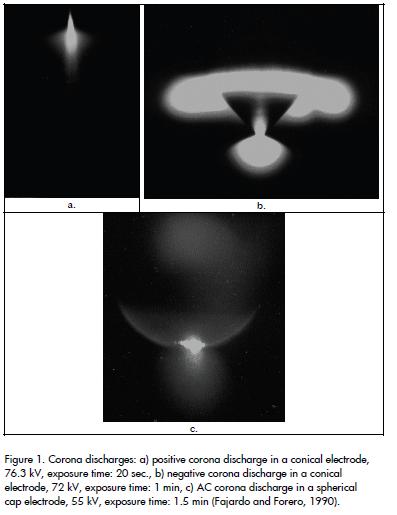
Another topic in which the EMC-UNC group was involved was related to contamination caused by low frequency electric and magnetic fields. Examples of this work are given in Jaimez et al. (1987), Román et al. (1987), Méndez and Román (1996), Rincón et al. (1999, 2001), Ramos et al. (2005) and Ramos (2006). The process for developing an electric field detector for human protection is mentioned in Ramos (2006) and Ramos et al. (2005). This device was constructed by the EMC-UNC group for the Cundinamarca Electricity Company (Empresa de Energía de Cundinamarca S.A. E.S.P).
An interesting relationship between low frequency magnetic fields and electrocardiographic alterations in subjects exposed to these types of fields for several years in electricity substations was mentioned in Méndez et al. (1996). Additionally, accidents caused by lighting discharge was another topic of interest for the group, viewed from an EMC perspective of interaction between lightning currents and victims, as mentioned in Román and Lötberg (2000), Román et al. (2005), Santamaria et al. (2006c and 2008). Figure 2 shows the main results of an investigation for understanding the interaction between lightning discharge and victim. Figure 2 shows soccer shoes destroyed by direct lightning impact on the victim (a), while traces left by the lightning current in the ground and on the soccer shoes are shown (b). Numbers 1-3 in Figure 2 b) shows how the current path became split into several paths. The burned grass around the shoes was probably caused by impulsive corona discharges. Figure 2 c) is a still photograph taken during a lab experiment when a 16 kA lightning-like current was injected to a leader boot. Several sparks can be seen in this photograph, indicating that the applied current can follow several paths on its way to the ground. The human body model used in the numerical calculations to understand the lightning accident is presented in Figure 2 d). This EMC investigation into a lightning accident led to demonstrating that a lightning current striking a grounded body can split into several individual current paths. From an EMC point of view, this result can be understood as a resistive coupling between lightning current and victim, caused by the victim's shoes' grounding resistance. Explanations of this resistive coupling effect were given in papers (Sanchéz and Román, 2000; Díaz and Román (2005b), Santamaria et al., 2005b, 2006a; Arévalo et al., 2006).
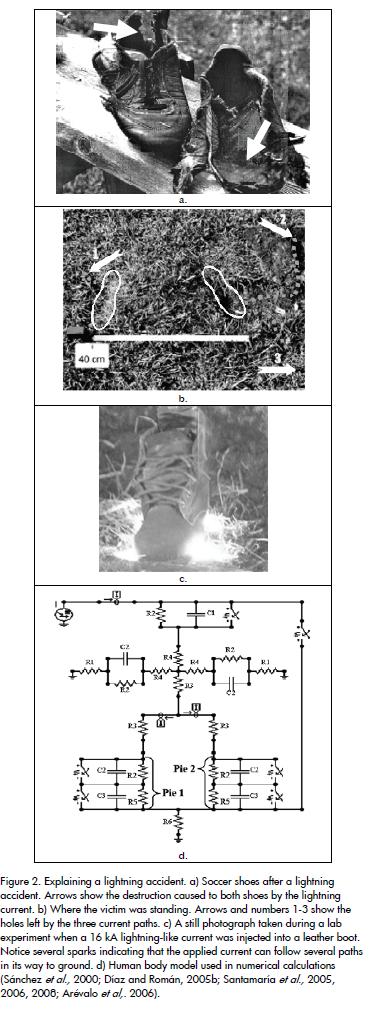
Distribution transformer failures
The number of distribution transformer failures in most countries was extremely low for almost three decades (from the 1960s to the 1990s) compared to the same figures for Colombia. The first distribution transformer failure statistics in Colombia were presented to the international community by Román (1990). Compared to the statistics presented by Mundim and Zubludowaki (1990), figures in Colombia were extremely high; the distribution transformer failure index was higher than 51% in certain areas of Colombia in 1990 (western area of Cundinamarca), 43% (Cundinamarca, Pacho), 16% (Santander, Barbosa). Such figures were lower than 0.8% in the USA, 1974 (REA,1961). This critical situation was initially studied by the EMC-UNC group in Torres et al. (1987), Román et al. (1988c), Román and Cuartas (1988), Patiño et al. (1989), Jiménez et al. (1992), Catañeda and Lemus (1991) and Casteñeda y Villamil (1992).
A research question was proposed for explaining the large number of distribution transformer failures. The hypothesis was called the Inductive-loops theory (Román, 1990, 1991a, 1991b, 1991c, 1991d; Fajardo and Forero, 1990). The large number of distribution failures could have been explained by the long distances left between lighting arresters and transformers. Due to an inductive effect, a large derivative lightning current could produce a large voltage drop in the cables connecting lightning arresters and transformers. Colombian distribution transformer installation regulations were based on foreign regulations: USA rural electrification administration (REA) regulations (1961). Figure 3 shows a typical example of applying the aforementioned REA standard. Figure 3 a) shows the large distance left between the lightning arrester (indicated by the arrows) and the distribution transformer. The loop formed by the long conductors between arrester and transformer was called an inductive loop. These magnetic loops were responsible for generating over-voltages on the transformer windings, higher than their basic insulation level (BIL). The solution to this problem was just to install the lightning arresters close to the transformer bushings, as indicated in Figure 3b).
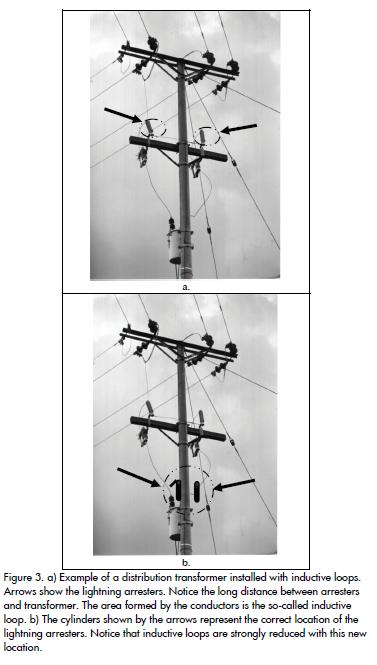
The REA regulations (1961) mentioned that distribution transformers protected by lightning arresters should fail less than 0.51% of the time every year, depending on the number of thunderstorm days and thunderstorm intensity. This was not the case for Colombia, a country having more than 110 thunderstorm days per year in certain areas such as the Rionegro basin.
EMC-UNC group's work aimed at resolving the distribution transformer problem was initially reported by Román (1993b) to the Bogotá Electricity Company2. Final conclusions were presented in COLCIENCIAS' final reports by Mejía and Román (2002a, 2002b).
It was necessary to measure lightning currents to test the inductive loop theory. Induced voltage VL in the inductive loops can be calculated using equation (1):

Where:
L is the inductance of the inductive loops. A typical value of L is 4 to 6 μH. di/dt is the lightning current derivative.
The lightning di/dt value should be taken from the known literature or determined by measurements in an experimental transmission line. This was the origin of three projects financed by COLCIENCIAS and the Universidad Nacional de Colombia (Mejia, Román and Román 1993, 2002a, 2002b). Lightning measuring devices had to be developed for this work: lightning flash counters (Román and Cuartas, 1988; Cuartas, 1989), lightning current amplitude detectors (Luna et al., 1987) and di/dt measuring devices (Roncery and Cortés, 1991). A CGR3 lightning flash counter developed by Mackerras and Darveniza (1986) was also used in this project.
The activities performed in the experimental line and the statistics for measuring lightning current were presented in papers (Román 1992a, 1992b, 1993; Román and Mejía, 1992; Castro and Bello, 1992; Gonzáles et al., 1992; Páez and Román, 1997; Román et al., 1998c). The main conclusions of this body of research work were summarised as follows:
1- Inductive loops theory could explain several modes of distribution transformer failures, such as short circuits in three windings;
2- As derived from inductive loops theory, the regulations for installing distribution transformers used in Colombia and inspired by REA regulations were not feasible for Colombia due to the large inductive loops;
3- The measurements performed in the experimental distribution line showed that induced over-voltages could operate distribution transformer arresters. Frequent and violent thunderstorm activity in Colombia could explain the reduced life of lightning arresters in this mainly rural region;
4- Due to its geographical location, Colombia could be classified as being a thunder-stormy country;
5- Several products emerged from this investigation. Some of them were related to studies on lightning arresters (Lizarazo and Vega, 1991; Páez and Román, 1997; Román et al., 1998c, 2001c, 2003a, 2003b, 2003c, 2003d, 2007; Román 1998a, 2000a, 2001b; Ramírez et al., 1998, 1999; Muñoz et al., 1999; Arias et al., 1999; Arias and Bernal, 1999; Arias and Román, 2001a, 2001b; Ortiz and Román, 2001, 2003a, 2003b; Alarcón et al., 2001, 2002; Román and Arias, 2001; Acero and Muñoz, 2003, 2004; Becerra et al., 2003a, 2003b, 2003c; Acero et al., 2004, 2006; Montaño et al., 2004; Díaz and Román, 2005a, 2005b, 2006, 2007; Ortíz et al., 2006; Alarcón and Román, 2007; Ortíz, 2005c; Arévalo, 2005; Mejía and Román, 2002b). The book by Arias et al., (2008) summarises several results obtained during this period.

Floating electrodes
A noticeable pattern was observed in several isolated metallic bodies during the campaign for resolving distribution transformer failures. A house having an isolated metal roof was struck by lightning, killing a small girl, several isolated metal pieces such as isolated lids from several distribution transformer tap changers were involved in lightning-related electrical discharges and a lightning accident involving an armed soldier left several unanswered questions about the interaction of floating electrodes and electrical discharges. The scientific questions formulated from this were: "How is the interaction between corona electrical discharge and electrically-isolated metallic bodies immersed in an electric field?" "Could a metallic body attract an electrical discharge?" These questions led to investigation into isolated metallic bodies or floating electrodes.
A floating electrode is an electrically-isolated metallic body immersed in an electric field. Figure 4 show examples of floating electrodes. The spherical electrode shown in Figures 4 a) and b) has its electric field concentration in the upper and lower side of the floating electrode. However, Figures 4 c) and d) show the electric field concentration when the spherical electrode has a protrusion. Electric field enhancement at the protrusion creates a corona current source in a region called primary gap region (see Figure 4 c). Corona ionic currents charge the spherical floating electrode, thereby increasing the electric field in the secondary gap region show in Figure 4 c). A discharge occurs when the electric field in the secondary gap region surpasses its breakdown electric field. This forms a floating electrode switch.
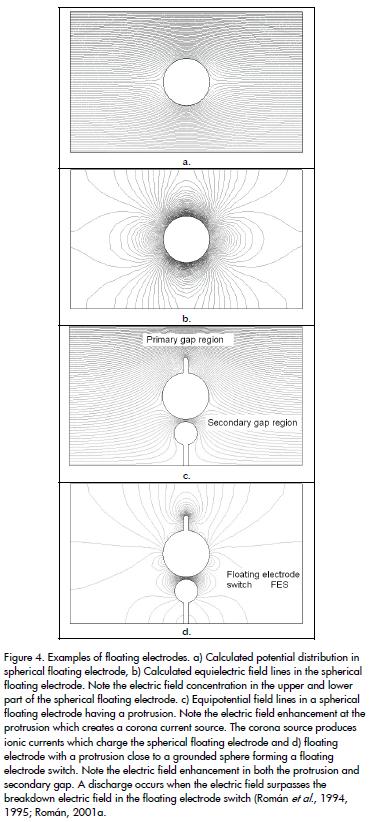
An electrostatically-accumulated charge on a floating electrode could have practical applications. This simple idea led to work in the following four research areas (Román, 1997c): Gas discharge physics and corona discharges, generating fast current impulses, developing a high impedance current source and harvesting energy from an electric field. This work resulted in developing four patented devices: An impulse current generator (Román, 1999b), an electric field measuring device (Román, 1999a; Román et al., 1997a), a high impedance DC current source (Román, 2001c) and a method for extracting energy from an electric field (Román, 1999c). Intensive work was initiated during the second half the 1990s and the first decade of the 2000s to solve scientific questions related to floating electrodes. The characteristics of insulated metallic bodies in very intense electric fields were studied in Román et al. (1994, 1995, 1996a, 1996b, 1998b), Román and Scuka (1995), Valencia and Velázquez (1998), Román, (1995b) and Valencia (2009).
Gas discharge physics and corona discharges
As mentioned above, gas discharge physics studies were initiated by simple observation of electrical phenomena (Solano and Suaza, 1986, 1988; Román et al., 1988d; Bulla et al., 1988; Torres and Zamudio, 1989; Fajardo y Forero, 1990; Román, 2001a). Later on, gas discharge physics theory and numerical methods for its calculation was studied (Román, 1982a, 1982b, 1988a; Fajardo et al., 1983; Castañeda et al., 1984; Amortegui et al., 1988; Castillo et al., 1990; Monsalve and Muñoz, 1989; Verbal, 1989; Román and Castillo, 1990; Díaz, 1991; Román et al., 1994, 1995, 1996a, 1998b, 1999a; Román and Scuka, 1995; Gomes et al., 1999; Bogoya et al., 1999a and 1999b; Arévalo et al., 2003a).
This initial work on gas discharge physics led to formulating a possible way of calculating breakdown voltage in long gaps in the so-called single stress method (SSM) (Román et al., 1997b, 1998a, 1999b, 2001a, 2001b; Román, 1995b, 1997c, 1998b, 2000b; Becerra et al., 1998, 1999a, 1999b; Gomes et al., 1999; Sánchez and Vargas, 1999; Sánchez et al., 2000; Becerra and Román, 2002b). Figure 5 shows how this method can be applied to investigating the breakdown voltage of two glass insulating columns using SSM (Becerra and Román, 2002a).
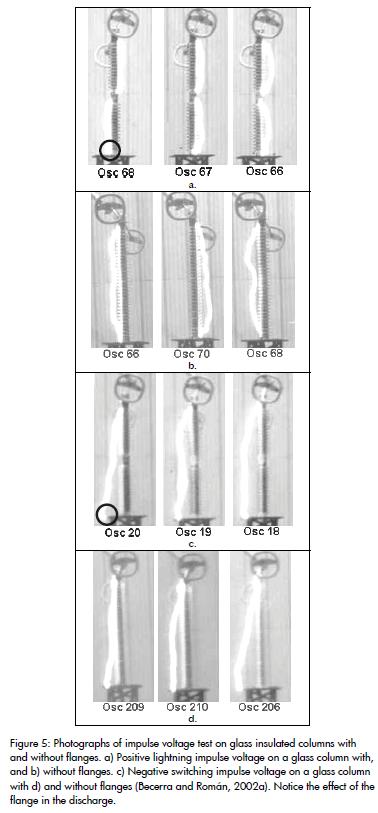
In, Becerra and Román (2003b) demonstrated that this method was not feasible for obtaining 50% probability breakdown voltage.
A new numerical calculation was initiated by Becerra in different works (Becerra and Román, 2002a, 2003a; Moreno et al., 2003). Corona numerical calculations were performed by Arévalo in Díaz and Arévalo (2002), Arévalo et al. (2003b, 2003c, 2004, 2005a, 2005b, 2005c, 2005d, 2005e, 2005f, 2006, 2008), Gomez et al. (2005), Díaz et al. (2007), Román and Arévalo (2007), Román et al. (2008b) and Arévalo (2005) following these studies. Some other efforts were directed towards obtaining canonical geometries' correction constants for breakdown voltage in the atmospheric conditions pertaining to Bogotá, Colombia (Bejarano and Romero, 2002; Romero et al., 2003; Bejarano et al., 2010; López and Gómez, 2003).
Corona experimental work was directed towards understanding the behaviour of corona sources in high voltage electric fields (Osorio and Rosero, 2003; Rojas et al., 2005; Forero et al., 2005; Mora et al., 2007; Alarcón et al., 2009; Alarcón, 2010). This work was directed towards capturing and accumulating the energy obtained from the electric field in batteries (Rojas, 2010).
Additionally, spark channel resistance was initially investigated in the EMC-UNC group in (Rodríguez et al., 1998; Rodríguez and Ospina, 1998). Later on, this work was directed towards model gas discharge switches (Díaz et al., 2008; Santamaria, 2010).
Lightning protection structures
One of the topics of interest when investigating distribution transformer failure concerned how to characterise the electromagnetic environment in the Rionegro basin. The aforementioned papers, as well as those mentioned in Román (1988f, 1990, 1991b, 1991d, 1992a), Patarrollo et al. (1988), Torres et al. (1989), Román and Mejía (1992), Castro and Bello (1992), Gonzáles et al. (1992), Díaz (1992), Román and Arias (2001), Becerra et al. (2003a) and Mejía and Román (2002a), were orientated towards instrumentation of an experimental transmission line for studying lightning and understanding the interaction between lightning and distribution transformer failure. However, some other activities were performed for understanding the physics of lightning. A lightning measurement campaign was undertaken in 2005 (Santamaria et al., 2005a); electric field devices were developed during this campaign (Santamaria et al., 2006b). Later on, the measured waveforms were compared to lightning signatures in Sri Lanka (Santamaria et al., 2006b) and Sweden (Santamaria, 2006).
Applications of this investigation orientated by Becerra (2007 and 2008) were performed in Miranda (2006), Becerra et al. (2006, 2008a and 2008b).
An example of a numerical calculation for a lightning channel using the software developed by Becerra (2008a, 2008b) is presented in Figure 6.
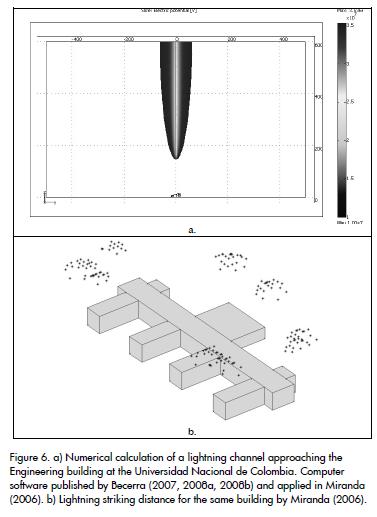
New work in this field corresponds to noise reducing lightning electric field signals using wavelets (Santamaria et al., 2009).
Impulse current generators
From the original ideas on current generators proposed in Román's patent (1999b) and in Román (1997c), new generators were developed as in Muñoz et al. (1999) and Muñoz and Velázquez (1999) to increase the amplitude of impulse current generators (Diaz and Román, 2005a, 2005b, 2006; Díaz, 2005). Figure 7 a) show the original 6 A, 3 ns rise in time current impulse generated by a floating electrode impulse current generator similar to that shown in Figure 4 d) (image taken from Román, 1997c). Figure 7 b) shows a 1,200 A, 5 ns rise time current impulse produced by the Román generator (RG) mentioned in Román et al. (2003b, 2003c) and Montaño et al. (2004). Figure 7 c) shows a 3,2 kA signal produced by the RG version constructed by Diaz and shown in Figure 7 d) (Díaz, 2005; Forero et al., 2005; Díaz and Román, 2005b, 2006, 2007; Díaz et al., 2008.
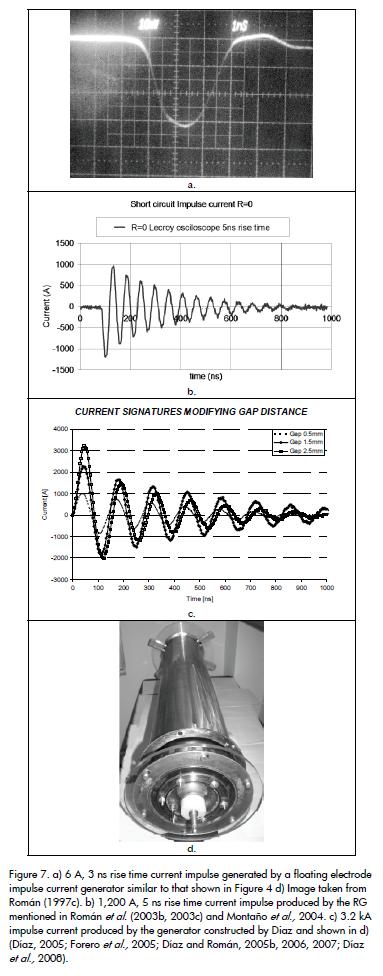
Figures 8 a) and b) show the experiments performed by Vega (2010) and Mora (2009) on a gas insulated switch to obtain an electrical model of the RG (Mora et al., 2008; Vega et al., 2009b). Vega et al. (2009b) and Mora (2009) predicted the RG impulse repetition frequency in their thesis work by developing an electromagnetic model of the corona source (called a corona tube by the latter).
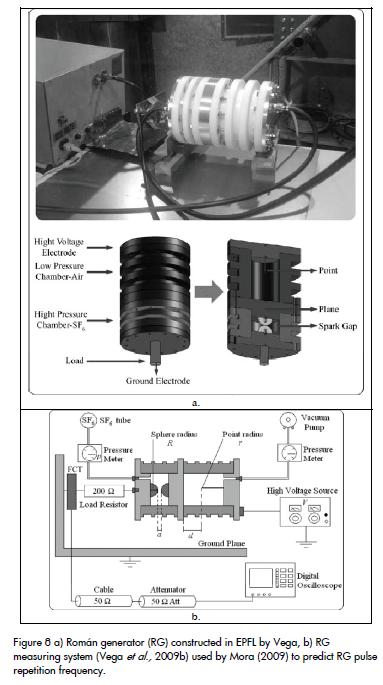
Investigation by Santamaría (2010) aimed at understanding the dynamic behaviour of electrical discharges in micro-gaps was focused on understanding arc channel dynamic impedance. Such discharge channel pattern was studied as a function of interelectrode distance and both gas type and pressure. The experimental set up shown in Figures 9 a), b) and d) was constructed to perform this investigation. Figure 9 a) shows the coaxial current generator while b) shows details of the D-dot measuring probe connection. Figure 9 c) shows some construction details while d) shows the equivalent circuit. The voltage drop across the switch and current in the circuit were measured to obtain the arc channel's dynamic impedance. Voltage was thus obtained from electric field measurements before and after the switch. An example of the measure voltage and current signals is given in Figures 10 a) and b). Notice that current rise time was less than 1 ns in Figure 10 a. Figure 10 b) shows rise time dependence on gas pressure.
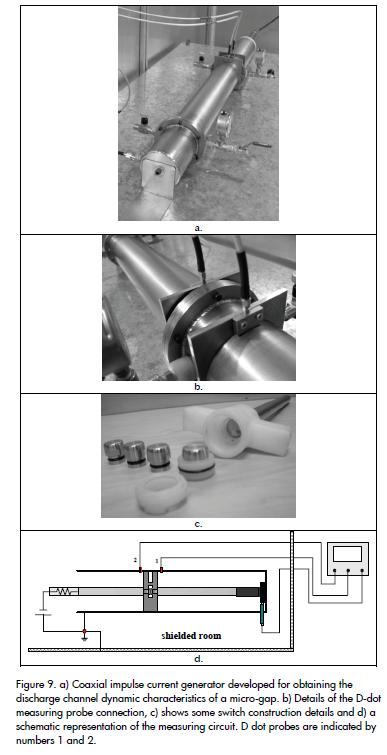
Ozone generation from corona discharges
Corona discharges have been used for generating ozone. The objective of an investigation sponsored by COLCIENCIAS (Román et al., 2006) was to optimise ozone generation by producing electrical discharges in dielectric barriers (Mora, 2010; Rojas, 2010). Figure 11 shows aspects of the experimental setup for generating ozone using a double dielectric barrier reactor. Corona electrical discharges were investigated in a coaxial configuration having different conductor lengths. Figure 12 shows a good correlation between corona current and ozone concentration. Mora (2010) has focused his work on investigating the correlation between corona current shape and ozone concentration. These results are of importance for future investigations into ozone generation for cleaning water.
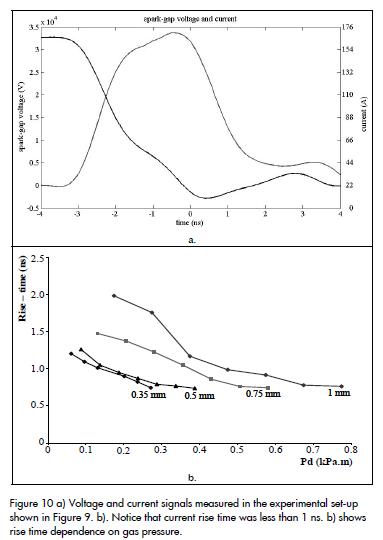
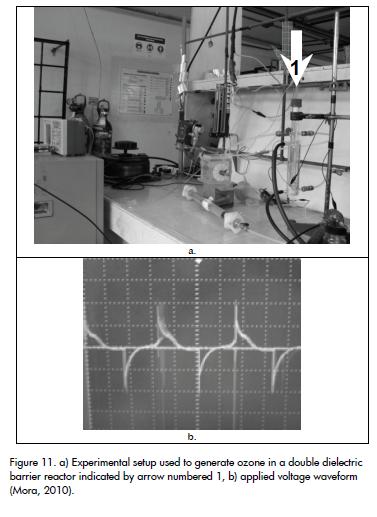
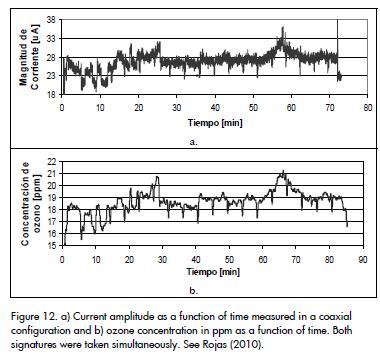
Energy from the electric field
The main idea in this investigation was to apply corona discharges to obtaining energy from the electric field. A. Rojas and Sanchez (2004) and Rojas (2005) and Mora et al., (2007) have investigated the simultaneous charging process of 50 rechargeable AA batteries using a corona source in a configuration called high impedance current source (ETHICS in Spanish) (Rojas and Sánchez, 2004; Rojas et al., 2005 and 2007). Figures 12 a) and b) taken from Rojas (2004) show, respectively, the experimental set up for activating the corona current source and the charged batteries (Rojas and Sánchez, 2004). This work concluded that this source can charge all series connected batteries with the same amount of charge. This conclusion is important for extrapolating this result to natural electric field sources.
Figure 14 shows a comparison of corona current produced by two types of corona electrodes. These electrodes will be used as an application of the previously explained experiment for charging batteries from the electric field. Ariza et al. (2010) compared a cactus-like electrode pattern to a single-needle electrode. It was concluded that both had similar behaviour in similar wind conditions. However, the advantage of using the former is its simplicity of construction, as can be seen in Ariza et al. (2010).
Radiating electromagnetic energy
As mentioned above, the EMC-UNC Group has been involved in generating fast current and voltage impulses. The limits reached by the group are in terms of amplitude (several kA) and in terms of rise-time the present limits is around 500 ps. It is well-known that devices in EMC practice should withstand different amplitudes from radiated electromagnetic fields. This was the origin of a new research question and a challenge for the EMC-UNC group: "Could the generated current impulses be radiated?" "Are there efficient ways of matching ultra wide antennas (UWA) to the generator, in such a way that generator electromagnetic energy can be efficiently radiated?"
>Several research activities have been initiated to solve these questions. Vega (2010) focused his work on designing a high power ultra wideband system using a fast impulse current generator. The first results were presented at URSI 2008 (Vega et al., 2008) in designing a mesoband high power electromagnetic radiator using a switched oscillator and a corona current generator. Vega et al. (2009a) has design and simulated an electromagnetic lens for a half impulse radiating antenna to match the antenna to the generator. Additionally, an UWB antenna fed by a corona source was tested as a source of interference. Figure 15 a) shows a radiating broad-band pulse generator with corona charging mechanism used for radiating the current impulse shown in Figure 15 b). Notice that measured electric field rise time at 20 m was 1.6 ns whilst amplitude was 110 V/m (Becerra et al., 2008a.
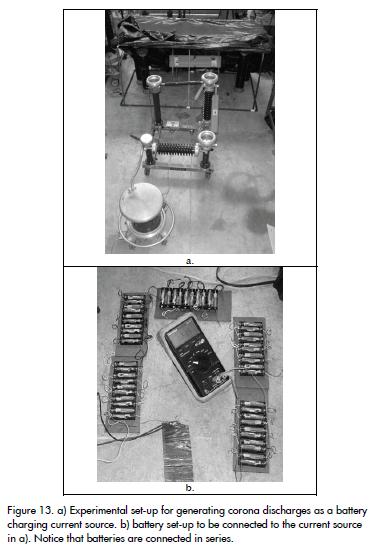
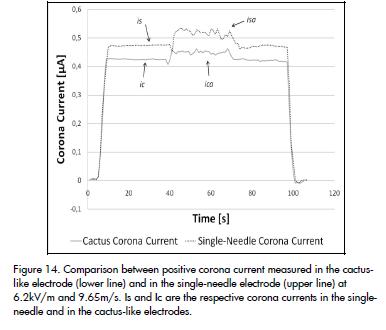
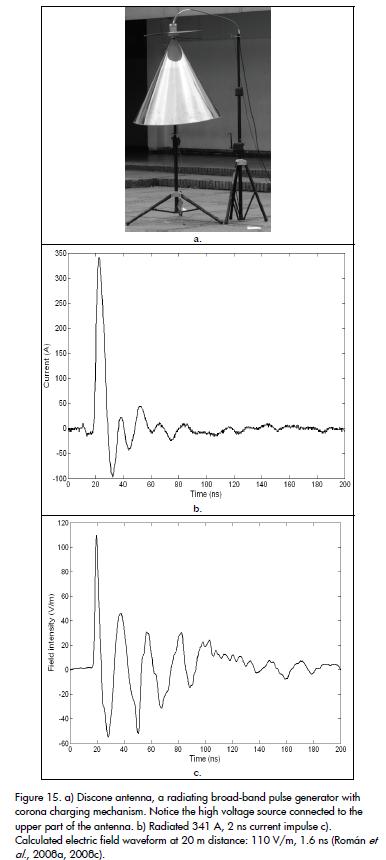
However, Vega (2010) will soon publish the final version of the system he has developed for radiating electromagnetic impulses using pulse forming line (PFL)-based types of generators.
It has been necessary to develop an EMC-lab to perform the EMC studies mentioned here. Figure 16 shows some aspects of the EMC-lab constructed with the support of the following companies: CODENSA, ECOPETROL, EEB, EMGESA, EPM, ISA, ISAGEN and the Universidad Nacional de Colombia. The shielded rooms represent the main experimental facility in this lab where measurements can be taken without electromagnetic noise.
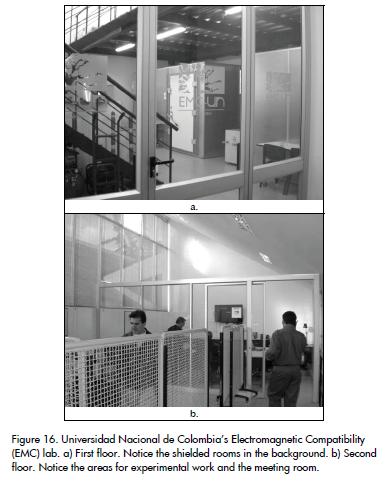
Future research activities
The EMC-UNC group's future research activities are related to applications involving gas discharge physics and generation and measuring fast current impulses in the picosecond range in pulsed power and intentional electromagnetic interference (IEMI) problems. This topic is of interest to stay in contact with Uppsala University. The group will increase its ability for developing measuring systems to help investigate electromagnetic interference in electrical and electronic systems as being important aspects of EMC immunity problems. This topic is of interest for the international cooperation agreement with the EPFL EMC group in Switzerland. The interaction of equipment and microwaves will be also investigated, especially by reinforcing experimental and numerical simulations of radiating such electromagnetic waves. Figure 17 shows an example of the calculations performed by the group regarding this topic. This work will increase present interaction with the GEST research Group of Prof. Nestor Peña at los Andes University in Colombia and Prof. K. Baum at the University of New Mexico, USA.
Several characteristics of lightning electromagnetic pulses (LEMP) in Colombia are still unknown, especially those related to lightning at high altitude compared to lightning at sea level. Collaboration with research groups in Uppsala, Stockholm and Gothemburg in Sweden, Switzerland, Sri Lanka, Mexico and Malaysia and Dr. Marley Becerra will continue. The final product of this research is to increase the protection capacity of lightning protection systems. Incorporating new techniques like wavelets (Santamaria et al., 2009) and other numerical techniques will be investigated in depth in the near future.
The investigation into harvesting energy from an electric field using electrical discharges will continue until this technology's real possibilities have been revealed. In the case of ozone production for cleaning water, the group will apply this technology to concrete cases. Finally, the possibility of increasing the internal impedance of high impedance current sources will be investigated to find some industrial applications for this.
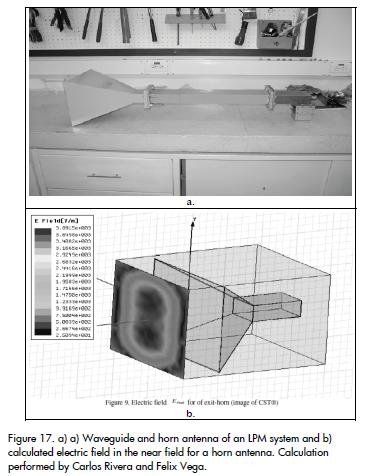
All EMC-UNC group activity is transferred to education in the Electrical and Electronics Department's graduate and postgraduate courses at the Universidad Nacional de Colombia. New books will be written on the research topics mentioned here to increase such activities.
Conclusions
The EMC-UNC group research activity's which has been carried out for almost three decades can be summarised as accumulating knowledge obtained by performing experiments, investigating gas electrical phenomena and solving a few research questions.
This investigation started by constructing experimental tools for observing high-voltage phenomena: electrical discharges in gases. The start made with simple tools involved the photographic recording of DC corona discharges. Later on, more sophisticated tools were developed and used for observing more complicated phenomena, such as lightning-induced currents. The increase in observation tool complexity was accompanied by developing computational modelling ability. The first stage finished by developing HV electrical equipment, such as voltage sources, and circuit components, such as resistors, inductors and capacitors.
A second stage involved resolving concrete EMC-problems, such as the destruction of equipment caused by lightning. The first research question posed was: "How can the extremely high Colombian distribution transformer failure-index be understood?" Directly observing damaged units provided the answer; damage was being caused by very high overvoltages. The inductive loop hypothesis was the correct answer to this question; the inductive loops theory involving reducing the inductive loops was formulated to solve this problem. Another solution was to reduce the induced overvoltages by using arresters along the line. The properties of wood were used to extract these overvoltages from the distribution lines. This work finished with a reduction of one order of magnitude in the distribution transformers' failure index. The group continues its studies into lightning discharges to solve a basic research question about the nature of lightning at high altitudes and a practical question on better lightning protection technologies.
Observing interacting floating electrodes with lightning discharges provided the origin for a second group of questions: "How do corona electrical discharges interact with floating electrodes?"
"How is the interaction between corona electrical discharges and electrically-isolated metallic bodies immersed in an electric field?" "Could a metallic body attract an electrical discharge?" Several hypotheses were formulated to answer these questions. The answer lay in understanding gas discharge physics. Corona discharge in a floating electrode was the main reason for the interaction between electrical discharges and isolated bodies. The electrostatically accumulated charge on a floating electrode could be used in several applications. Four patented devices were developed following this idea.
Formulating new impulse generators was the origin of new research questions: "Could generated current impulses be radiated?" "Are there efficient ways of matching ultra wide antennas (UWA) to a generator in such a way that the generator's electromagnetic energy can be efficiently radiated?" The answers to these questions led to developing impulse radiating systems and led the EMC group towards the field of pulsed power technology. A device based on the use of pulse forming lines (PFL) will be presented at the end of this year.
Another answer led to studying harvesting energy from an electric field. The present interest in this study lies in evaluating the possibilities of this source as a feasible energy source.
Another derived investigation has been related to ozone production, directed related to the knowledge gained in gas discharge physics.
The radiating energy derived from pulse power technology has directed the EMC-UNC research group towards becoming involved in microwave technologies for radiating energy in a more efficient way.
Acknowledgements
The author would like to thank the Universidad Nacional de Colombia for supporting this research group for almost 30 years. The author is also very thankful to COLCIENCIAS for supporting this research work almost from the early beginning and the PhD studies of the author and some of his students. Several companies from the energy sector have supported the group during the last four years through the Cattleya Project: CODENSA, ECOPETROL, EEB, EMGESA, EPM, ISA, ISAGEN and the Universidad Nacional de Colombia. The author is deeply grateful to more than 200 students who have collaborated in this work since 1982; however, it is necessary to mention the names of some distinguished coinvestigators: professors Antonio Mejia, Nestor Peña, Camilo Cortes, and Dr. Marley Becerra, PhD candidates Felix Vega and Francisco Santamaria, MSc students Andrea Rojas, Carlos and Nicolas Mora, Orlando Paez, Jairo Arias and E.E. Rodrigo Jaimes, Oscar Montero, Carlos Rivera, David Ariza, Oscar Escobar and Sandra Bernal.
Bibliografía
Abondano, A., Santoyo, C., Guzmán, C., Prediseño de un laboratorio de Alta Tensión con fines hacia la Industria, La docencia y la Investigación., BSc Electrical Engineering thesis, Universidad Nacional de Colombia, Bogotá, 1984. [ Links ]
Acero, L., Muñoz, E., Modelamiento de los contadores de energía eléctrica y su Protección contra Descargas Atmosféricas., Tesis de grado presentada a la Universidad Nacional de Colombia, para optar al grado de Ingeniero electricista, 2003. [ Links ]
Acero, L., Muñoz, E., Soluciones al daño de Contadores en la Zona de Samaná, Caldas., Mundo Eléctrico Colombiano, No. 54, 2004, pp. 22-27. [ Links ]
Acero, L., Muñoz, E., Román, F., Soluciones al daño de transformadores en la zona de samaná, Caldas., Mundo Eléctrico Colombiano, Vol. 18 No. 54, enero-marzo, 2004, pp. 36-41L. [ Links ]
Acero, L., Munoz, E., Román, F., Soluciones al daño de transformadores en la zona de Samaná, Caldas., II Congreso Internacional Sobre Uso Eficiente y Racional de la Energía CIUREE, 2006, V.18, fasc. 54, ISSN: 1692-7052, 2006, pp.36 – 41. [ Links ]
Acosta, J., Bernal, A., Hurtado, A., El Efecto Corona. Métodos Experimentales de Medición., tesis presentada a la Universidad Nacional de Colombia, Bogotá, para optar al grado de Ingeniero Electricista, 1986. [ Links ]
Alarcón, A., Quevedo, J., Murillo, L., Mora. C., Vega, H., Gamboa, H., Martínez, J., Román F., Caracterización de Varistores Mediante una Fuente de Corriente de Muy Alta Impedancia., V Jornadas Latinoamericanas y II Iberoamericanas en Alta Tensión y Aislamiento Eléctrico ALTAE, Paper Altae 043, Cuba, 2001. [ Links ]
Alarcón, A., Martínez, J., Gamboa, L., Caracterización de Descargadores de Distribución Utilizando una Fuente de Corriente DC de Alta Impedancia., Tesis de grado presentada a la Universidad Nacional de Colombia, para optar al grado de Ingeniero Electricista, 2002. [ Links ]
Alarcón, A., Román F., Current-Voltage Characteristics of Semiconductor Glaze., 15th International Symposium on High Voltage Engineering, ISH 2007, Ljubljana, Slovenia, August 27 31, 2007. [ Links ]
Alarcón, A., Gómez, C., Santamaría, F., Román, F., Study of the behaviour of the corona current under controlled environmental conditions., X International Symposium on Lightning Protection ICLP, ISSN: 2176-2759, 2009. [ Links ]
Alarcón A., Comportamiento del efecto corona en configuración coaxial bajo condiciones de presiòn controladas para aire., M. Sc. thesis at the Universidad Nacional de Colombia to be finished, 2010. [ Links ]
Amórtegui, F., Cano, L. E., Diseño y Construcción de un Condensador de Alta Tensión aislado en Agua., tesis presentada a la Universidad Nacional de Colombia, Bogotá, para optar al grado de Ingeniero Electricista, 1986. [ Links ]
Amórtegui, F., Bojacá, F., Gómez, C., Cálculos básicos y construcción preliminar de un Generador de Impulsos de Corriente., BSc Electrical Engineering thesis, Universidad Nacional de Colombia, Bogotá, 1984. [ Links ]
Amórtegui, F., Román, F., Gutierrez., Atenuación de descargas atmosféricas en líneas de transmisión., V Jornadas Nacionales de transmisión y Distribución de Energía Eléctrica, Bogotá, ACIEM, 1988. [ Links ]
Angarita, J., Programa para cálculo de Campos Electrostáticos., tesis presentada a la Universidad Nacional de Colombia, Bogotá, para optar al grado de Ingeniero Electricista, 1988. [ Links ]
Arévalo, L., Diaz, O., Román, F., Adding negative corona currents produced by independent electrodes in a cylindrical coaxial configuration., Memorias del ISH, Delf, Holanda, 2003a. [ Links ]
Arévalo, L., Diaz, O., Román, F., Estudio de la impedancia aparente producida por el efecto Corona negativo., ALTAE, Costa Rica, 2003b. [ Links ]
Arévalo, L., Diaz, O., Román, F., Corriente Corona para electrodos en un arreglo de Cilindros Coaxiales., Revista Mundo Eléctrico Colombiano, ISSN: 0120-8926, Vol.17, fasc.50, 2003c, pp. 90 – 93. [ Links ]
Arévalo, L., Díaz, O., Gómez, C., López, H., Román, F., Behavior of the Corona Effect in Franklin Tips., Memorias de la Conferencia Internacional de Protección contra Rayos, Avignon, Francia, ICLP 2004, 2004. [ Links ]
Arévalo, L. P., Comportamiento de la carga espacial en un arreglo de cilindros coaxiales., M. Sc. thesis presented at the Universidad Nacional de Colombia, 2005. [ Links ]
Arévalo, L., Becerra, M., Román, F., Positive corona current simulation in a non - uniform coaxial arrangement., Memorias del word scientific and engineering academy and society wseas., Transactions on information science and applications, ISSN 1790 – 0832, Vol. 2, No. 10, October, 2005a. [ Links ]
Arévalo, L., Becerra, M., Román, F., Negative corona simulation at atmospheric pressure on cylindrical coaxial arrangement., Memorias del word scientific and engineering academy and society - wseas., Transactions on information science and applications, ISSN 1790 – 0832, Vol. 2, No. 10, October, 2005b. [ Links ]
Arévalo, L., Becerra, M., Román, F., Discharge Geometry behavior in negative corona at atmospheric pressure on a cylindrical arrangement., Memorias del word scientific and engineering academy and society - wseas., 2005c. [ Links ]
Arévalo, L., Becerra, M., Román, F., Discharge Geometry behavior in a positive corona simulation in a non uniform coaxial arrangement., Memorias del word scientific and engineering academy and society - wseas., 2005d. [ Links ]
Arévalo, L., Becerra,M., Román, F., Numerical Simulations of the Corona Current Development., Memorias del VIII International Symposium on Lightning Protection, São Paulo, Brazil, 21st-25th November, 2005e. [ Links ]
Arévalo, L., Becerra, M., Román, F., Numerical simulaing positive corona current behavior., Memorias del ISH 2005 - Proceedings of the XIVth international symposium on high voltage engineering, ISBN 7 - 302 - 01581 – 3, Beijing, China, Tshingua Univeristy, August 25-29, 2005f. [ Links ]
Arévalo, L., Becerra M., Román F., Understanding the point discharge DC current produced by corona needles., paper IX-13, p.p.1328-1333, 28th International Conference on Lightning Protection ICLP, Kanazawa Japan, sept. 18-22, 2006. [ Links ]
Arévalo, L., Román, F., Cooray, V., Montano, C., Breakdown effect on long gaps under switching impulses statistical variation., 29th International Conference on Lightning Protection ICLP, 2008. [ Links ]
Arias, J., Bernal, S., Román, F., Modificación del Modelo del Descargador de Sobretensiones de ZNO, para Ondas Tipo Paso Frontal Utilizando el Programa ATP/EMTP., Mundo Eléctrico Colombiano, Vol. 13, No. 37, oct., dic., 1999, pp. 149-153. [ Links ]
Arias, J., Bernal, S., Modelo integral de protecciones y transformador de distribución para el ATP/EMTP y PSPICE., tesis presentada a la Universidad Nacional de Colombia, Bogotá, para optar al grado de Ingeniero Electricista, 1999. [ Links ]
Arias, J., Román, F., Análisis Estadístico de Señales Inducidas por Descargas Subsecuentes del Rayo en una Línea de Prueba ubicada en La Palma, Cundinamarca, Colombia., V Jornadas Latinoamericanas y II Iberoamericanas en Alta Tensión y Aislamiento Eléctrico ALTAE, Paper Altae 007, Cuba, 2001a. [ Links ]
Arias J., Román F., Análisis de Sobretensiones y Energía Disipada en los Descargadores de Sobretensión en una Línea de Prueba Debido a Voltajes Inducidos por Descargas Subsecuentes del Rayo., V Jornadas Latinoamericanas y II Iberoamericanas en Alta Tensión y Aislamiento Eléctrico ALTAE, Paper Altae 017, Cuba, 2001b. [ Links ]
Arias, J., Gómez, C., López, H., Ramírez, C., Román, F., Modelamiento de protecciones utilizando ATP, V. 1., editorial Facultad de Ingeniería, Universidad Nacional de Colombia, Bogotá – Colombia, ISBN: 978-958-701-829-5, 2008, pp. 135. [ Links ]
Ariza, D., Escobar, O., Román, F., Corona current in a cactus-like electrode in natural-like electric field: comparison with a single needle electrode., paper submitted to the ICLP 2010, Cagliari, Italy, 2010. [ Links ]
Becerra, E., García, E., Método Experimental para la medición del Campo Eléctrico., tesis presentada a la Universidad Nacional de Colombia, Bogotá, para optar al grado de Ingeniero Electricista, 1989. [ Links ]
Becerra, H., Vásquez and Arenas, A., Método del esfuerzo simple para el estudio probabilístico de la descarga., tesis presentada a la Universidad Nacional de Colombia, Bogotá, para optar al grado de Ingeniero Electricista, 1998. [ Links ]
Becerra, H., Vásquez, G., Arenas, A., Román, F., Determinación del Voltaje Representativo en el Método del Esfuerzo Simple., IV Jornadas Latinoamericanas y II Iberoamericanas en Alta Tensión y Aislamiento Eléctrico ALTAE, Paper Altae 100, Medellín, Colombia, Octubre, 1999a. [ Links ]
Becerra, H., Vásquez, G., Arenas, A., Román, F., Single Stress Method. Método del Esfuerzo Simple para el Estudio Probabilístico de las Descargas Eléctricas en el Aire., Mundo Eléctrico Colombiano, Vol. 13, No. 34, ene-mar., 1999b, pp. 77-83. [ Links ]
Becerra, M., Román, F., A Monte Carlo method to simulate electrical discharge in gases in nonuniform field., Memorias del Annual Report Conference on Electrical Insulation and Dielectric Phenomena, Cancun, Mexico, IEEE CEIDP 2002, 2002a. [ Links ]
Becerra, M., Román, F., Obtaining the electrical parameters of the predischarge in air by using digitized voltage waveforms., Memorias delAnnual Report Conference on Electrical Insulation and Dielectric Phenomena, Cancún, Mexico, IEEE CEIDP 2002, 2002b. [ Links ]
Becerra, M., y Román, F., Calculaing corona onset voltages using a microscopic Monte Carlo simulation method., Memorias del XII Intern. Symp. on High Voltage Engineering ISH 2003, Netherlands, 2003a. [ Links ]
Becerra, M., Román, F., The Single Stress Method –SSM- as high voltage test procedure., Memorias del VII Intern. Symp. On Lightning Protection SIPDA, Santos, Brazil, 2003b. [ Links ]
Becerra, M., Moreno, M., Román, F., Digital Parametrization for Metal-oxide surge arrester models., Memorias del VII Intern. Symp. On Lightning Protection SIPDA. Santos, Brazil, 2003a. [ Links ]
Becerra, M., Moreno, M., Román, F., Parametrización digital de modelos de limitadores de sobretensión para frentes rápidos., ALTAE, Costa Rica, 2003b. [ Links ]
Becerra, M., Moreno, M., Román, F., Digital Parameter Identification for Metal-Oxide Surge Arrester Models (ref. 146)., Memorias del VII SIPDA, Curitiva, Brasil, 2003c. [ Links ]
Becerra, M., Cooray, V., Román, F., Striking Distance of Vulnerable Points to be struck by Lightning in Complex Structures., paper VI-15, p.p.608-613, 28th International Conference on Lightning Protection, ICLP 2006, Kanazawa, Japan, sept 18-22, 2006. [ Links ]
Becerra, M., Cooray, V., Román, F., Lightning striking distance of complex structures., IET Generation, Transmission and Distribution, ISSN: 1751-8695, Vol. 2, No. 1, 2008a, pp. 131–138. [ Links ]
Becerra, M., Román, F., Cooray, V., Lightning Attachment to Common Structures: Is the Rolling Sphere Method Really Adequate?., 29th International Conference on Lightning Protection, Uppsala, Sweden, 23rd - 26th June, 2008b. [ Links ]
Bejarano, L., Romero, A., Estudio de la influencia de la humedad bajo condiciones controladas en la disrupción del aire, a la altura de Bogotá, para un arreglo de electrodos homogéneos, configuración esfera-esfera., Tesis de grado presentada a la Universidad Nacional de Colombia, para optar al grado de ingeniero electricista, 2002. [ Links ]
Bejarano, L., Romero, A., Román, F., Influence of humidity on the breakdown voltage of a sphere - sphere gap at 2600 mosl., Memorias del ISH, Delf, Holanda, 2003. [ Links ]
Bogoya, A., Cortés, C. y Román, F., Ecuación para Corrección de la Disrupción del Aire en Bogota con Condiciones Controladas de Temperatura y Humedad para Ondas Tipo Maniobra en un Arreglo Punta-Placa., IV Jornadas Latinoamericanas y II Iberoamericanas en Alta Tensión y Aislamiento Eléctrico ALTAE, Paper Altae 70, Medellin, Colombia, Octubre, 1999a. [ Links ]
Bogoya, A., Cortés, C., Román, F., Estudio de la Disrupción del Aire en Bogota., Mundo Eléctrico Colombiano, Vol. 13, No. 36, jul., sep., 1999b, pp. 104 - 108. [ Links ]
Bohorquez, A., Zambrano, H., Laboratorio de Alta Tensión para pruebas de transformadores: Equipo para medida de descargas parciales y Tangente Delta., tesis presentada a la Universidad Nacional de Colombia, Bogotá, para optar al grado de Ingeniero Electricista, 1987. [ Links ]
Bulla, M., Gonzáles, J., Iglesias, G., Física del Efecto Corona., tesis presentada a la Universidad Nacional de Colombia, Bogotá, para optar al grado de Ingeniero Electricista, 1988. [ Links ]
Castañeda, G., Franco, E., Garzón, M., Determinación del campo eléctrico mediante el método de simulación de Cargas., BSc Electrical Engineering thesis Universidad Nacional de Colombia, Bogotá, 1984. [ Links ]
Castañeda, J., Lemus, H., Teoría de los Lazos Inductivos Parte II., tesis presentada a la Universidad Nacional de Colombia, Bogotá, para optar al grado de Ingeniero Electricista, 1991. [ Links ]
Castañeda, J., Villamil, R., Análisis de las fallas de transformadores de Distribución., tesis presentada a la Universidad Nacional de Colombia, Bogotá, para optar al grado de Ingeniero Electricista, 1992. [ Links ]
Castillo, G., Román, F., Torres, H., Mejía, A., Evaluación de pérdidas Corona en Líneas de transmisión., VI Jornadas nacionales de Energía de ACIEM, Bogotá, ACIEM, mayo, 1990. [ Links ]
Castro, L., Bello, A., Caracterización geográfica, Meteorológica y geomorfológica de la Zona de la Palma., tesis presentada a la Universidad Nacional de Colombia, Bogotá, para optar al grado de Ingeniero Electricista, 1992. [ Links ]
COLCIENCIAS., Estudio de casos y controles: Reducción de fallas de transformadores de distribución., 75 Maneras de generar conocimiento en Colombia. 1990 – 2005, Casos Seleccionados por los Programas Nacionales de Ciencia, Tecnología e Innovación, Bogotá: Instituto Colombiano para el Desarrollo de la Ciencia y la Tecnología Francisco José de Caldas COLCIENCIAS, ISBN: 958-8290-13-9, 2006, pp. 174-175. [ Links ]
Cuartas, W., Construcción de un contador de descargas atmosféricas de 10 MHz., tesis presentada a la Universidad Nacional de Colombia, Bogotá, para optar al grado de Ingeniero Electricista, 1989. [ Links ]
Dams, J., Dunz, Th., Küchler, A., Román, F., Untersuchung der Impulsformung am Wasserisolierten Generator PIMPF., Jahresbericht Hochspannungsinstitut, Universität Fridericiana, Karlsruhe, 1982. [ Links ]
Diaz, J., Herrera, F., Ramírez, M., Análisis de alternativas de sincronización para la prueba de Impulso con el osciloscopio., tesis presentada a la Universidad Nacional de Colombia, Bogotá, para optar al grado de Ingeniero Electricista, 1987. [ Links ]
Diaz, A., Pinzón, J., Diseño y construcción de elementos de Alta Tensión., tesis presentada a la Universidad Nacional de Colombia, Bogotá, para optar al grado de Ingeniero Electricista, 1988. [ Links ]
Diaz, N., Programa de cálculo de campo eléctrico y pérdidas corona en líneas de transmisión., tesis presentada a la Universidad Nacional de Colombia, Bogotá, para optar al grado de Ingeniero Electricista, 1991. [ Links ]
Diaz, L., El Campo Magnético de líneas de Transmisión., tesis presentada a la Universidad Nacional de Colombia, Bogotá, para optar al grado de Ingeniero Electricista, 1992. [ Links ]
Díaz, O., Arévalo, L., Estudio de la Física del Efecto Corona para Diferentes Configuraciones de Electrodos en un Arreglo de Cilindros coaxiales., Tesis de grado presentada a la Universidad Nacional de Colombia para optar al grado de maestría en Ingeniería Eléctrica, Calificación Meritoria, 2002. [ Links ]
Diaz, O., Román, F., A new fast impulse current generator based on the floating electrodes properties., ISH 2005 - Proceedings of the XIVth international symposium on high voltage engineering, Beijing, China, Tshingua Univeristy, ISBN 7 - 302 - 01581 – 3 August 25-29, 2005a. [ Links ]
Díaz, O., Román, F., Spark Gap Behaviour in a Compact Electrostatic Fast Impulse Current Generator., Memorias del VIII International Symposium on Lightning Protection, São Paulo, Brazil, 21st-25th November, 2005a. [ Links ]
Diaz, O., Román, F., Design and Construcing a compact electrostatics fast impulse current generator., Memorias del The 15th IEEE International Pulsed Power Conference, Monterey, California, June 13 – 17, 2005b. [ Links ]
Diaz O. J., Design and construcing a fast impulse current generator based on the floating electrode principle., M. Sc. thesis presented at the Universidad Nacional de Colombia, 2005. [ Links ]
Diaz O., Román F., Improveing the Output Current Response of an Electrostatic Fast Impulse Current Generator#., 28th International Conference on Lightning Protection ICLP, paper IX 26, Kanazawa Japan, sept. 18-22, 2006, pp.1395-1399. [ Links ]
Díaz, O., Arévalo, L., Román, F., Understanding the corona space charge influence on the ESD-like discharge produced by a floating electrode in a fast impulse current generator., IX SIPDA, International Symposium on Lightning Protection, Foz do Iguacu, Brazil, 26th-30th November, 2007. [ Links ]
Diaz, O., Román, F., Spark Gap Behaviour in a Compact Electrostatic Fast Impulse Current Generator., VIII International Symposium On Lightning Protection, SIPDA, ISSN: 1676-9899, 2007. [ Links ]
Diaz, O., Cooray, V., Román, F., Spark gap resistance for an electrostatic discharge at different pressures., 35th IEEE International Conference on Plasma Science, ISSN: 0730-9244, 2008. [ Links ]
Fajardo, M., Pinzón, L. M., Rodríguez, H., Determinación del Campo Eléctrico por el método de las Diferencias Finitas., BSc Electrical Engineering thesis, Universidad Nacional de Colombia, Bogotá, 1983. [ Links ]
Fajardo, J., Forero, C., Física del Efecto Corona., tesis presentada a la Universidad Nacional de Colombia, Bogotá, para optar al grado de Ingeniero Electricista, 1990. [ Links ]
Forero, L., Chavarro, J., Valenzuela, R., Román, F., Corona points discharge current measurement on atmospheric electric field., Memorias del ISH 2005 - Proceedings of the XIVth international symposium on high voltage engineering, Beijing, China, Tshingua Univeristy, ISBN 7 - 302 - 01581 – 3, August 25-29, 2005. [ Links ]
Godoy, C., Tique, G., Construcción de un puente para la medición de la Capacidad y la Tangente Delta., tesis presentada a la Universidad Nacional de Colombia, Bogotá, para optar al grado de Ingeniero Electricista, 1987. [ Links ]
Gomes, C., Lan, G., Cooray, V., Román, F., Breakdown characteristics of 500 mm and 250 mm long sparks over insulating surfaces., Eleventh International Symposium on High Voltage Engineering ISH 99, Londres, UK, agosto, 1999. [ Links ]
Gomez, C., Lopez, H., Román, F., Corona impulse current produced by hyperboloidical tips in a coaxial cylindrical setup., Memorias del ISH 2005 - Proceedings of the XIVth international symposium on high voltage engineering, Beijing, China, Tshingua Univeristy, ISBN 7 - 302 - 01581 – 3, August 25-29, 2005. [ Links ]
Gonzáles, M., Palomá, D., Guarín, J., Línea Experimental de medición en La Palma, Cundinamarca., tesis presentada a la Universidad Nacional de Colombia, Bogotá, para optar al grado de Ingeniero Electricista, 1992. [ Links ]
INTERCONEXION ELECTRICA S.A., - ISA- Proyecto ISA-CESI para el diseño de laboratorios de la Serie 110kV para la Industria Colombiana con el personal Italiano: Prof. G. Carrara, Dr. G. Rizzi, Dr. E. Warnotts, Dr. D. Perinelli. January-June, 1988. [ Links ]
Jaimez, R., Nontoa, C., Ortíz, D., Efectos del campo eléctrico en los seres vivos., tesis presentada a la Universidad Nacional de Colombia, Bogotá, para optar al grado de Ingeniero Electricista, 1987. [ Links ]
Jiménez, J., Martín, S., López, C., Fallas en Sistemas Telefónicos., tesis presentada a la Universidad Nacional de Colombia, Bogotá, para optar al grado de Ingeniero Electricista, 1992. [ Links ]
Linares, N., Pava, L., Reformulación de prácticas de Alta Tensión., tesis presentada a la Universidad Nacional de Colombia, Bogotá, para optar al grado de Ingeniero Electricista, 1987. [ Links ]
Lizarazo, L., Vega, J., Teoría de los Lazos Inductivos., tesis presentada a la Universidad Nacional de Colombia, Bogotá, para optar al grado de Ingeniero Electricista, 1991. [ Links ]
López, H., Gómez, C., Caracterización de la Corriente Corona Acumulativa producida por Electrodos Hiperboloides en una Configuración de Cilindros Coaxiales., Tesis de grado presentada a la Universidad Nacional de Colombia para optar al grado de Ingeniero electricista, 2003. [ Links ]
Luna, J., Montaño, M., Jurado, A., Medidas de Magnitud de Corriente en descargas atmosféricas., tesis presentada a la Universidad Nacional de Colombia, Bogotá, para optar al grado de Ingeniero Electricista, 1987. [ Links ]
Mackerras, D., Darveniza, M., Describing a project for worldwide measuring of the ratio of cloud flash top ground flashes in lightning storms., University of Queensland, Departing Electrical Engineering, Report No. EE 86/9, June, 1986. [ Links ]
Mejía A., Román F., Torres H., Estudio teórico y experimental de las sobretensiones en el Sistema de Potencia Eléctrico Colombiano., research work supported by COLCIENCIAS, Years: 1983- 1985, Final Research Report, 1985. [ Links ]
Mejía A., Román F., Caracterización de las Descargas Eléctricas Atmosféricas en Colombia., research work supported by COLCIENCIAS and the National University, Years: 1989- 1993, Final Research Report, 1993. [ Links ]
Mejía A., Román F., Compatibilidad Electromagnética y Coordinación del Aislamiento., research work supported by the Universidad Nacional de Colombia, years: 1999 - 2002, code DIB- U. Nacional: 808099, final report, 2002a. [ Links ]
Mejía A., Román F., Reducción de las fallas de trasformadores de distribución: un estudio de casos y controles., research work supported by COLCIENCIAS and the National University, Years: 1999- 2002, Final Research Report, 2002b. [ Links ]
Melo, R., Ponce, C., Triviño, N., Generación y Medida de Tensiones de Impulso y Construcción de un generador de Pulsos para el encendido y corte de la onda de choque principal., BSc Electrical Engineering thesis, Universidad Nacional de Colombia, Bogotá, 1984. [ Links ]
Méndez, A., Román, F., Román, G., Electrocardiographic Alterations in Subjects Chronically Exposed to Nonionizing High Intensity Electromagnetic Fields. Radiovetenskap och Kommunikation 96 (RVK 96) Luleå and Kiruna, reunión mundial de la URSI, Lille, Francia (URSI 96), Suecia, 1996. [ Links ]
Miranda J., Cálculo de la distancia de impacto del rayo en estructuras complejas., tesis presentada a la Universidad Nacional para optar al grado de Ingeniera Electricista, 2006. [ Links ]
Monsalve, E., Muñoz. S., Modelo Computacional para la Carga Espacial., tesis presentada a la Universidad Nacional de Colombia, Bogotá, para optar al grado de Ingeniero Electricista, 1989. [ Links ]
Montaño, R., Edirisinghe, M., Cooray, V., Román, F., Varistor models- a comparison between theory and practice., Memorias de ICLP 2004, Avignon, Francia, 2004. [ Links ]
Mora, C., Rojas, A., Gómez, C., Román, F., Corona Current Generation on a Coaxial Configuration with Low Potentials., 15th International Symposium on High-Voltage Engineering, ISH 2007, Ljubljana, Slovenia, August 27-31, 2007. [ Links ]
Mora, N., Vega, F., Román, F., Peña, N., Rachidi, F., Corona Charged Subnanosecond Impulse Generator., 20th International Zurich Symposium on Electromagnetic Compatibility, 2008. [ Links ]
Mora, N., Electrical model of the Román generator., MSc thesis, Universidad Nacional de Colombia, 2009. [ Links ]
Mora, C., Análisis de la producción de ozono en descarga silenciosa mediante la aplicación de varias formas de onda de tensión., MSc thesis, Universidad Nacional de Colombia, 2010. [ Links ]
Moreno, M., Becerra, M., Román, F., Calculaing the Corona onset using a macroscopic Monte Carlo simulation method., Memorias del International Symposium on High Voltage Engineeing ISH, Delf, Holanda, 2003. [ Links ]
Mundim, A., Zubludowaki, G., Transformadores de Distribucao. Desempenho sob descargas atmosfericas., The First International Conference on Power Distribution, ISIDEE Belo Horizonte, Brazil, November 11-14, 1990. [ Links ]
Muñoz, D., Velásquez, A., Román, F., Desarrollo de un Generador de Impulsos de Corriente con Electrodos Flotantes., Mundo Eléctrico Colombiano, Vol. 13, No. 35, abr-jun., 1999, pp. 117-120. [ Links ]
Muñoz, D., Velázquez, A., Diseño preliminar y construcción de un prototipo de generador de impulsos de corriente con electrodos flotantes., tesis presentada a la Universidad Nacional de Colombia, Bogotá, para optar al grado de Ingeniero Electricista, 1999. [ Links ]
Ortiz H., Román F., Degradación en Descargadores de Sobretensión de Oxido Metálico Tipo Distribución. Estudio de caso: Vereda el Trigo, Cundinamarca, Colombia., V Jornadas Latinoamericanas y II Iberoamericanas en Alta Tensión y Aislamiento Eléctrico ALTAE, Paper Altae 009, Cuba, 2001. [ Links ]
Ortiz, H., Román, F., Experimental Study of the conventional metal – oxide distribution surge arresters with an intentionally connected series gap., Memorias del ISH, Delf, Holanda, 2003a. [ Links ]
Ortíz, H., Román, F., Experimental Study of Conventional Metal Oxide Distribution surge arresters with an intentionally connected series gap (ref. 057)., Memorias del VII SIPDA, Curitiva, Brasil, 2003b. [ Links ]
Ortiz H., Acevedo C., Ibañez H., Román F., Modeling of metal – oxide distribution surge arresters with an intentionally connected series gap., 28th International Conference on Lightning Protection ICLP 2006, paper VI-41, Kanazawa, Japan, sept 18 22, 2006, pp.991-995. [ Links ]
Osorio G., Rosero, R., Disminución del Campo Eléctrico de Inicio del Efecto Corona mediante la utilización de distintas configuraciones de Electrodos basadas en las formas de la Naturaleza., Tesis de grado presentada a la Universidad Nacional de Colombia para optar al grado de Ingeniero Electricista, 2003. [ Links ]
Paéz, O., Román F., Las fallas de los transformadores de distribución., simposio Nacional del CIDET, Bogotá, 1997. [ Links ]
Patarroyo, S., López, J., Gutierrez, R., Atenuación de descargas atmosféricas en líneas de transmisión., tesis presentada a la Universidad Nacional de Colombia, Bogotá, para optar al grado de Ingeniero Electricista, 1988. [ Links ]
Patiño, J., Monroy, F., Soto, V., Correlación entre fallas de líneas de transmisión y descargas eléctricas atmosféricas., tesis presentada a la Universidad Nacional de Colombia, Bogotá, para optar al grado de Ingeniero Electricista, 1989. [ Links ]
Ramírez, C., Rodriguez, F., Borbón, M., Román, F., Simulación de Varistores y Tubos de Gas aplicando Models., Mundo Eléctrico Colombiano, Vol. 12, No. 33, oct.,dic., 1998, pp. 123-127. [ Links ]
Ramírez, C., Rodríguez, F., Borbón, M., Mejía, A., Román F., Modelamiento en Atp-Models de Varistores y Tubos de Gas como Elementos de Protección en Baja Tensión., IV Jornadas Latinoamericanas y II Iberoamericanas en Alta Tensión y Aislamiento Eléctrico ALTAE, Paper Altae 72, Medellín, Colombia, Octubre, 1999. [ Links ]
Ramos, J., Vega, F., Lopez, H., Román, F., Electric field detector for human protection., Memorias del ISH 2005 - Proceedings of the XIVth international symposium on high voltage engineering, Beijing, China, Tshingua Univeristy, ISBN 7 - 302 - 01581 – 3, August 25-29, 2005. [ Links ]
Ramos, J. M., Diseño y construcción de un medidor de campo eléctrico., MSc thesis, Universidad Nacional de Colombia, 2006. [ Links ]
REA (1961) Rural Electrification Administration., US Department of Agriculture, 1961, Application guide for Transformers, July, Chapter VIII Lightning Protection, 1959. [ Links ]
Rincón, L., Socadagüi, J., Jaimes, R., Mejía, A., Román, F., Medición y Reglamentación sobre Exposición a los Campos Eléctricos y Magnéticos de Extra Baja Frecuencia en Subestaciones Eléctricas Colombianas., IV Jornadas Latinoamericanas y II Iberoamericanas en Alta Tensión y Aislamiento Eléctrico ALTAE, Paper Altae 74, Medellín, Colombia, Octubre, 1999. [ Links ]
Rincón, L., Socadagui, J., Román, F., Medición y Reglamentación sobre Exposición a los Campos Eléctricos y Magnéticos de Extra Baja Frecuencia en subestaciones eléctricas Colombianas., Mundo Eléctrico Colombiano, ISSN: 0120-8926, Vol.15, No. 42, 2001, pp. 66 – 71. [ Links ]
Rodríguez, M., Ospina, A. y Román F., Cálculo de la Resistencia del Canal y de la tensión disruptiva de una descarga electrostática tipo streamer con energía limitada., Mundo Eléctrico Colombiano, Vol. 12, No. 33, oct.,dic., 1998, pp. 113 - 117. [ Links ]
Rodríguez, M., Ospina L., Modelo de una descarga tipo Streamer con energía limitada., tesis presentada a la Universidad Nacional de Colombia, Bogotá, para optar al grado de Ingeniero Electricista, 1998. [ Links ]
Rojas, F. A., Sánchez, J. F., Estudio del comportamiento de la carga de baterías de uso doméstico AA y AAA por medio de fuentes de corriente Corona., Tesis de grado presentada a la Universidad Nacional de Colombia para optar al grado de Ingeniero electricista, 2004. [ Links ]
Rojas, A., Sanchez, J., Mora, C., Román, F., Charging rechargeable cells using a high impedance current source., Memorias del ISH 2005 - Proceedings of the XIVth international symposium on high voltage engineering, Beijing, China, Tshingua Univeristy, ISBN 7 - 302 - 01581 – 3, August 25-29, 2005. [ Links ]
Rojas F. A., Influencia de las barreras dieléctricas en la formación de descargas eléctricas en una configuración coaxial., MSc thesis, Universidad Nacional de Colombia, 2010. [ Links ]
Román, F., Die Berechnung Elektrostatischer Felder mit NASTRAN, Studien Arbeit Universität Fridericiana, Karlsruhe, 1982a. [ Links ]
Román, F., Teoría de las descargas Eléctricas en Gases., Curso de Actualización en Alta Tensión, Bogotá, ACIEM, October, 1982b. [ Links ]
Román, F., Método de los elementos finitos para el cálculo de campos electrostáticos., Revista Ingeniería e Investigación, Facultad de Ingeniería Universidad Nacional de Colombia, No. 4, 1982c, pp. 35-45. [ Links ]
Román, F., Medidas de Alta Tensión., Cali, Colombia, Universidad del Valle, January, 1983. [ Links ]
Román, F., Medidas y Pruebas en Alta Tensión Curso de Actualización., Pereira, Colombia, Universidad Tecnológica de Pereira, 1984. [ Links ]
Román, F., Abondano, A., Santoyo, C., Investigaciones Básicas para el prediseño de un Laboratorio de Alta Tensión, con fines hacia la Docencia, la Industria y la Investigación., I Jornadas sobre Transmisión y Distribución de Energía Eléctrica, Bogotá, Colombia, ACIEM, May, 1984. [ Links ]
Román, F., Amórtegui, F., Bojacá, F., Gómez, C., Construcción de un Generador de Impulso de Corriente y del Sistema Asociado de Medida, para ensayo de pararrayos., Ingeniería e Investigación, Vol. 3, No. 3, 1985a, pp. 30-39. [ Links ]
Román, F., Melo, R., Once, C., Triviño, N., Control de Generación de la Onda de Choque y Medición de sus tiempos característicos., Ingeniería e Investigación, Vol. 3, No. 2, 1985b, pp. 33-42. [ Links ]
Román, F., Prácticas Docentes de Alta Tensión para fines didácticos en Ingeniería., Ingeniería e Investigación, Vol. 4, No. 1, 1986. [ Links ]
Román, F., Jaimes, R., Nontoa, C., Ortiz, D., El Campo Eléctrico en Líneas de Transmisión: Análisis Computacional y Efectos Biológicos., VI Jornadas Nacionales de Subtransmisión y Distribución de Energía Eléctrica, Bogotá, ACIEM, 1987 y en X Congreso Nacional de Aciem, Pereira, ACIEM, Junio, 1987. [ Links ]
Román, F., Medidas y pruebas en Cables, El Campo Eléctrico en Cables Apantallados. Control del Campo Eléctrico., Curso de Cables de Alta Tensión, Pereira, Colombia, Universidad Tecnológica de Pereira, 1988a. [ Links ]
Román, F., El Campo Eléctrico de las Líneas de Transmisión., Tesis de Maestría presentada a la Universidad Nacional de Colombia, Bogotá, para optar al grado de M.Sc. en Sistemas de Potencia, 1988b. [ Links ]
Román, F., Cuartas, W., Detector y Contador de descargas Eléctricas Atmosféricas., V Jornadas Nacionales de transmisión y Distribución de Energía Eléctrica, Bogotá, ACIEM, 1988. [ Links ]
Román,F., Zambrano H., Bohorquez,A., Determinación experimental de la capacidad y tangente delta en transformadores., V Jornadas Nacionales de transmisión y Distribución de Energía Eléctrica, Bogotá, ACIEM, 1988a. [ Links ]
Román, F., Godoy, C., Tique, G., Diseño y construcción de un puente para la medición de capacidad y tangente delta., V Jornadas Nacionales de transmisión y Distribución de Energía Eléctrica, Bogotá, ACIEM, 1988b. [ Links ]
Román, F., Torres, H., Mejía, A., Investigación en Alta Tensión Part I, II., V Jornadas Nacionales de transmisión y Distribución de Energía Eléctrica, Bogotá, ACIEM, 1988c. [ Links ]
Román, F., Torres, H., Bulla, E., Gonzales, J., Iglesias, G., Física del Efecto Corona. Análisis cualitativo., V Jornadas Nacionales de transmisión y Distribución de Energía Eléctrica, Bogotá, ACIEM, 1988d. [ Links ]
Román, F., Consideraciones acerca del diseño, operación y seguridad de los laboratorios docentes de alta tensión. Publicación de la Facultad de Ingeniería de la Universidad Nacional, 1989. [ Links ]
Román, F., Distribution Transformer Failures caused by Lightning Arrester Operation in the Presence of External Overvoltages., First international conference on Power distribution, Belo Horizonte, Brasil, 1990. [ Links ]
Román, F., Castillo, G., Metodología para la evaluación de pérdidas corona en líneas de transmisión., Ingeniería e Investigación, No. 21, 1990. [ Links ]
Román, F., Un Problema Colombiano: Las Fallas de los Transformadores de Distribución. Un análisis a la luz de la Teoría de los Lazos Inductivos., XII Congreso Nacional de Ingeniería Eléctrica, Mecánica, Electrónica y Afines, Barranquilla, Colombia, noviembre 1,2,3, 1991a. [ Links ]
Román, F., Las Fallas de los Transformadores de distribución., Revista ACIEM, mayo 26-28, 1991b. [ Links ]
Román, F., La Teoría de los Lazos Inductivos y las fallas de los transformadores de distribución., VII Jornadas Nacionales de Energía, Bogotá, ACIEM, mayo 15-17, 1991c. [ Links ]
Román, F., Análisis de las fallas en transformadores de distribución causadas por la operación del pararrayos ante sobretensiones externas., Ingeniería e Investigación, No. 22, 1991d, pp. 34-36 y VIII Jornadas Nacionales de Energía, Bogotá, ACIEM, 1991d. [ Links ]
Román, F., Línea experimental para el estudio de los rayos Proyecto LEER., IX Jornadas nacionales de Energía, Bogotá, Colombia, ACIEM, mayo 27 – 28, 1992a. [ Links ]
Román, F., Distribution transformers failures and Lightning activity in Colombia., 21 International Conference on Lightning Protection, Berlín, septiembre 22-25, 1992b. [ Links ]
Román, F., Mejía, A. The First Lightning Measurement in the Field in Colombia., 21 International Conference on Lightning Protection, Berlín, septiembre 22-25, 1992. [ Links ]
Román F., Los trabajos alrededor de la teoría de los lazos inductivos., Seminario de investigadores en Ingeniería de Alto Voltaje, Publicación Universidad Nacional de Colombia, Seccional Medellín, Facultad de Minas, Departamento de Electricidad y Electrónica, Medellín, marzo 13 -19, 1993. [ Links ]
Román, F., Lötberg, E., Högberg, R., Scuka, V., Electrical characteristics of insulated metallic bodies in a lightning breakdown field., 22nd International Conference on Lightning Protection (ICLP), Budapest, Hungary, septiembre 19-23, 1994. [ Links ]
Román, F., Guide to the laboratory on insulation co-ordination, Suecia, Uppsala Universitet, UURIE 267-95, V. 100, 1995a, pp. 40. [ Links ]
Román, F., The influence of a floating electrode on the breakdown voltage of a complex gap Phil., Lic. Thesis at the Institute of High Voltage Research, Uppsala University, Document UURIE 269-95L, Uppsala, Sweden, 1995b. [ Links ]
Román, F., Scuka, V., The influence of a series micro-gap on the breakdown voltage of a complex gap arrangement containing floating electrodes, FE., 9th International Symposium on High Voltage Engineering (ISH), Graz University of Technology, Graz, Austria, agosto 28-septiembre 1, 1995. [ Links ]
Román, F., Cooray, V., Scuka, V., The corona onset voltage as a funcing the curvature radius of floating electrodes., XI International Conference on Gas Discharges and their Applications (GD95), Tokyo, Japan, septiembre 11-15, 1995. [ Links ]
Román, F., Cooray, V., Scuka, V., Corona from Floating Electrodes., Journal of Electrostatics, Vol. 37, 1996a, pp. 67-78. [ Links ]
Román, F., Cooray, V., Scuka, V., Breakdown Characteristics of Rod-to-Plane Arrangements with Floating Electrodes on the High Voltage Side., Nordic Insulation Symposium, NORD-IS 96, Bergen 10-12, 1996b, pp. 355-362. [ Links ]
Román, F., Cooray, V., Scuka, V., The Principle of Operaing a single Electrostatic field Measuring Device., 8th International Conference on Electrostatics, Poiters, Francia, Junio, 1997a. [ Links ]
Román, F., Cooray, V., Scuka, V., The single stress method to Study the Physical Properties of Discharge Processes in Air., 10th International Symposium on High Voltage Engineering ISH 97, Montreal, Canada, agosto, 1997b. [ Links ]
Román, F., Effects of Electric Field Impulses Produced By electrically Floating Electrodes on the Corona Space Charge Generation and on the Breakdown Voltage of Complex Gaps., Suecia: Almqvist & Wiksell International, ISBN: 9155438822, Vol. 200, 1997c, pp. 112. [ Links ]
Román, F., El Rayo, fenómenos físicos, Parámetros., Seminario sobre Protección Integral contra Sobretensiones Eléctricas, Asesel, Sena, ITEC, Bogota, Mayo, 1998a. [ Links ]
Román, F., Effects of Electric Field Impulses Produced by Electrically Floating Electrodes on the Corona Space Charge Generation and on the Breakdown Voltage of Complex Gaps., Mundo Eléctrico Colombiano, Vol. 12, No. 32, jul.,sep., 1998b, pp. 121. [ Links ]
Román, F., Cooray, V., Scuka, V., Comparison of the breakdown probability of Rod-plane Gaps with Floating Electrode., IEEE Transactions on Dielectrics and Electrical Insulation, Vol. 5, No. 4, Ag., 1998a, pp. 622-624. [ Links ]
Román, F., Cooray, V., Scuka, V., Comparison of the Breakdown Probability of two sphere-rod gaps, one conventional and the other with a floating electrode., 23rd International Conference on Lightning Protection (ICLP-96), Firenze, Italia, 1996, pp. 569-573 and IEEE Transactions on Dielectrics and Electrical Insulation, Vol. 5, No. 4, Ag., 1998b, pp. 622-624. [ Links ]
Román, F., Mejia, A., Paez, O., Las Fallas de los transformadores de distribución, un estudio de casos y Controles., Ponencias de la Propuesta de investigación en las Empresas de Energía del Huila, Cundinamarca, Central Hidroeléctrica del Cauca, EPM y Universidad Nacional de Colombia sede Medellín, CHEC, 1998c. [ Links ]
Román, F., Electrostatic Field Measuring Device Based on Properties of Floating Electrodes for Detecting Whether Lighting is Imminent, United States Patent, 5,892,363, Apr. 6, 1999a. [ Links ]
Román, F., Repetitive and Constant Energy Impulse Current Generator., United StatesPatent 5,923,130, Jul. 13, 1999b. [ Links ]
Román, F., Method and Apparatus Using a Floating Electrode to Extract Energy From an Electric Field., United States Patent, 5,939,841, Aug. 17, 1999c. [ Links ]
Román, F., Cooray, V., Scouka, V., Increase in the visual Corona From Floating Electrodes., Journal of Electrostatics, Fundamentals, Applications and Hazards, Vol. 45, 1999a, pp. 243-254. [ Links ]
Román, F., Cooray, V., Scouka, V., A Comparative Study of Corona Discharges in a Coaxial Cylinder Using Electric Field Impulses Generated by Electrically Floating Electrodes., Journal of Electrostatics, Fundamentals, Applications and Hazards, Vol. 45, 1999b, pp. 99-120. [ Links ]
Román, F. Ejemplo de Compatibilidad Electromagnética y las Normas de la IEC para la Protección contra Rayos., Mundo Eléctrico Colombiano, Vol. 14, No. 38, ene.,mar., 2000a, pp. 77-80. [ Links ]
Román F., Comparación de la Tensión Disruptiva de Dos Columnas Aislantes Utilizando el Método de los Esfuerzos Múltiples., Mundo Eléctrico Colombiano, Vol. 14, No. 41, 2000b, pp. 87-89. [ Links ]
Román, F., Lötberg, E., Informe sobre un Accidente causado por un Rayo en un Campo de Futbol. Hille; Gävle, Suecia el 29 de Julio de 1994., Mundo Eléctrico Colombiano, Vol. 14, No. 39, abr.,jun., 2000, pp. 120-123. [ Links ]
Román, F., A Self-Charging Mechanism of a Floating Electrode Based on Corona Discharges., Mundo Eléctrico Colombiano, Vol. 15 No. 43, abril – junio, 2001a, pp. 92-93. [ Links ]
Román, F., A New Extra High Impedance Current Source ETHICS., Mundo Eléctrico Colombiano, Vol. 15, No. 45, octubre – diciembre, 2001b, pp. 97-99. [ Links ]
Román, F., Fuente de Corriente de Alta Impedancia., Patente Colombiana, 28417, enero 31, 2001c. [ Links ]
Román, F., Arias, J., Energy Absorption on Distribution Lightning Arresters Due to Induced Lightning Currents on a Colombian Experimental Line., Memorias del VI International Symposium on Lightning Protection VI Sipda, Santos Brazil, 19 - 23 Nov., 2001, pp. 89 - 94. [ Links ]
Román, F., Becerra, M.,Bejarano, L.,Romero, A., López, H.,Villalobos, A., Comparación de la Tensión Disruptiva de dos Columnas Aislantes Utilizando el Método del Esfuerzo Simple., V Jornadas Latinoamericanas y II Iberoamericanas en Alta Tensión y Aislamiento Eléctrico ALTAE, Paper Altae 026, Cuba, 2001a. [ Links ]
Román, F., Becerra, M.,Bejarano, L., Romero, A.,López, H.,Villalobos, A., Comparison of The Breakdown Voltage of Two Insulating Columns Using The Simple Stress Method., Memorias del VI International Symposium on Lightning Protection VI SIPDA, Santos Brazil, 19 - 23 Nov. 2001b, pp. 323 - 328. [ Links ]
Román, F., Carrasco, J.,Ramírez, C., Arias, J., Sobretensiones Debidas a la Inductancia Serie Formada por los Conductores de Conexión de los Descargadores de Sobretensión Análisis y Solución., Mundo Eléctrico Colombiano, Vol. 15, No. 44, 2001c, pp. 24-27. [ Links ]
Román, F., Alarcón, A., Martínez, J., Gamboa, L., A new method to obtain the degradaing surge arresters using an Extra High Impedance DC Current Source., Memorias del ISH, Delf, Holanda, 2003a. [ Links ]
Román, F., Montaño, R., Cooray, V., Response of Low Voltage Protective Devices under subsequent stroke-like impulse currents., Memorias del ISH, Delf, Holanda, 2003b. [ Links ]
Román, F., Montaño, R., Cooray, V., Varistor Response under Subsequent Stroke-like impulse currents., Memorias del ISH, Delf, Holanda, 2003c. [ Links ]
Román, F., Alarcón, A., Martínez, J., Gamboa, L., A New Method to obtain the degradaing surge arresters using an Extra High Impedance DC Current Source (ref. 056)., Memorial del VII SIPDA, Curitiva, Brasil, 2003d. [ Links ]
Román, F., De las ideas a las patentes: Un ejemplo de la génesis de cuatro patentes en la Universidad Nacional., Revista Ingeniería al día, ISSN: 1794-2039, Vol.2, 2004, p.4 – 5. [ Links ]
Román, F., Alarcón, A., Santamaría, F., Analysis of a Lightning Accident in Gavle, Sweden., Memorias del VIII International Symposium on Lightning Protection, São Paulo, Brazil, 21st-25th November, 2005. [ Links ]
Román F., Rodriguez G., Trujillo C., Mora C., Rojas A., Energy from the Electric Field., (Obtención de Energía del Campo Eléctrico), research work supported by COLCIENCIAS - ISA and Universidad Nacional de Colombia, code 1101-332-19038, Contract RC 193-2006, 2006. [ Links ]
Román, F., Arévalo L., Theoretical and Experimental Behavior of Corona Needles Sources., 15th International Symposium on High-Voltage Engineering, ISH 2007, Ljubljana, Slovenia, August 27-31, 2007. [ Links ]
Román, F., Vega, F., Santamaria F., Herrera J., Diaz O., Study of a Sensor for Measurements of High Amplitude - Fast Rise Time Currents in a Coaxial Cable., 15th International Symposium on High-Voltage Engineering, ISH 2007, Ljubljana, Slovenia. August 27-31, 2007. [ Links ]
Román, F., Peña, N., Herrera, J., Santamaria, F., Mora, N., Aguilera, E. Diaz, O., Vega, F., Radiating Broad-Band Pulse Generator with Corona Charging Mechanism., EUROEM 2008, European Electromagnetics. Lausanne Suiza, 21-25 Julio, 2008a. [ Links ]
Román, F., Peña, N., Arévalo, L., Santamaria, F., Herrera, J., Alarcón, A., Vega, F., Investigation on the Transmission of a DC Current through a Space Gap., EUROEM 2008, European Electromagnetics, Lausanne Suiza, 21-25 Julio, 2008b. [ Links ]
Román, F., Peña, N., Herrera, J., Santamaría, F., Mora, N., Aguilera, E., Díaz, O., Vega, F., Radiating broad-band pulse generator with corona charging mechanism., Euroem, Lausanna, 2008c. [ Links ]
Romero, A., Bejarano, L., Román, F., Influence of Humidity on the Breakdown Voltage of a Sphere-Sphere Gap, at 2600 m OSL., ALTAE, Costa Rica, 2003. [ Links ]
Roncery, J., Cortés, W. Medición del di/dt de Descargas Atmosféricas mediante cintas., tesis presentada a la Universidad Nacional de Colombia, Bogotá, para optar al grado de Ingeniero Electricista, 1991. [ Links ]
Sánchez, A., Gómez, S. y Ortega, E., Desarrollo y construcción de los sistemas de control, alimentación y medida mediante bobinas de Rogowsky para un generador de Impulsos de Corriente., tesis presentada a la Universidad Nacional de Colombia, Bogotá, para optar al grado de Ingeniero Electricista, 1987. [ Links ]
Sánchez, A., Vargas, C., Caracterización de la predescarga para impulsos de voltaje tipo descarga eléctrica atmosférica DEAT., tesis presentada a la Universidad Nacional de Colombia, Bogotá, para optar al grado de Ingeniero Electricista, 1999. [ Links ]
Sánchez, A., Vargas, C., Román, F., Caracterización de la Predescarga Eléctrica en el Aire., Mundo Eléctrico Colombiano, Vol. 14, No. 40, jul.,sep., 2000, pp. 115-118. [ Links ]
Santamaría, F., Vega, F., Román, F., Calibraing a Lightning Electric Field Measuring System in Colombia., Memorias del III Simposio Internacional sobre Calidad de la Energía Eléctrica SICEL, 2005a. [ Links ]
Santamaría, F., Alarcón, A., Román, F., Analysis of a Lightning Accident in Gavle, Sweden., Memorias del VIII International Symposium On Lightning Protection, SIPDA, 2005b. [ Links ]
Santamaria F., Caracterización de las descargas eléctricas atmosféricas en Bogotá y comparación con registros tomados en otros lugares del mundo., MSc thesis, Universidad Nacional de Colombia, 2006. [ Links ]
Santamaría, F., Gomes, C., Román, F., Comparison Between the Signatures of Lightning Electric Field Measured in Colombia and that in Sri Lanka., 28th International Conference on Lightning Protection ICLP 2006, Kanazawa Japan, sept 18-22, 2006a, pp. 253-256. [ Links ]
Santamaría, F., Vega, F., Román, F., Experimental Analysis of a Parallel Antenna Used in Lightning Electric Measurements., 28th International Conference on Lightning Protection ICLP 2006, Kanazawa Japan, sept 18-22, 2006b, pp.376-381. [ Links ]
Santamaria F., Alarcon A., Román F., Analysis of a Lightning Accident Considering a Modified Human Body Model., 28th International Conference on Lightning Protection ICLP, paper VIII 12, pp.1249-1253, Kanazawa Japan, sept 18-22, 2006c. [ Links ]
Santamaria F., Diaz, O., A. Alarcon, Román, F., Behaviour of the Shoe-to-Earth Contact Under Lightning-Like Current Impulses., 29th International Conference on Lightning Protection, Uppsala, Sweden, 23rd - 26th June, 2008. [ Links ]
Santamaría, F, Cortés, C., Román, F., Noise Reducing Measured Lightning Electric Fields Signals Using The Wavelet Transform., X International Symposium on Lightning Protection, ISSN: 2176-2759, 2009. [ Links ]
Santamaria, F., Experimental research work on a sub-millimeter spark-gap for sub-nanosecond gas breakdown., a Ph.D thesis to be presented at the Univerisdad Nacional de Colombia, 2010. [ Links ]
Solano, R., Suaza, J. V., Determinación Teórico Experimental de la Distribución de Campo y potencial en Cadenas de Aisladores., tesis presentada a la Universidad Nacional de Colombia, Bogotá, para optar al grado de Ingeniero Electricista, 1986. [ Links ]
Solano, J., Suaza, T., Román, F., Distribución de potencial en cadenas de aisladores. Estudio Teórico-Experimental., X Congreso Nacional de Aciem, Pereira, ACIEM, Junio de 1987 y en Boletines Técnicos Gamma, Electroporcelanas Gamma, 1ª Edición, Octubre, 1988. [ Links ]
Torres, H., Román, F., Mejía A., Estudio Teórico Experimental de las Sobretensiones en el Sistema Eléctrico Colombiano., X Congreso Nacional de Aciem, Pereira, ACIEM, Junio, 1987. [ Links ]
Torres, C., Zamudio, J., Distribución de Potencial y Campo Eléctrico en Cadenas de Aisladores., tesis presentada a la Universidad Nacional de Colombia, Bogotá, para optar al grado de Ingeniero Electricista, 1989. [ Links ]
Torres, H., Román, F., Castaño, O., Comportamiento ante Descargas Atmosféricas de la Línea Torca-Calera-Circo 115kV., Revista ACIEM, Bogotá, NS09 y Primer Premio Icel, EEB, diciembre, 1989. [ Links ]
Valencia, J., Velázquez, J., Medición de campos eléctricos por medio de un electrodo flotante., tesis presentada a la Universidad Nacional de Colombia, Bogotá, para optar al grado de Ingeniero Electricista, 1998. [ Links ]
Valencia, J., Caracterización de un interruptor de voltaje, basado en las propiedades de los electrodos flotantes, para uso en sistemas de potencia pulsante., M.Sc. thesis, Universidad Nacional de Colombia, 2009. [ Links ]
Vega, F., Rachidi, F., Peña, N., Román, F., A Design of a Mesoband High Power Electromagnetic Radiator Using a Switched Oscillator and a Corona Current Generator., 2008 URSI General Assembly, 2008. [ Links ]
Vega, F., Rachidi, F., Mora, N., Peña, N., Román, F., Design and Simulaing an Electromagnetic Lens for a Half Impulse Radiating Antenna., International Conference on Electromagnetics in Advanced Applications, 2009a. [ Links ]
Vega, F., Mora, N., Román, F., Peña, N., Rachidi, F., Daout, B., Design and Construcing a Corona Charged High Power Impulse Generator., 17th IEEE International Pulsed Power Conference, 2009b. [ Links ]
Vega, F., Design of a high power ultra wideband system using a fast impulse current generator., a Ph.D. thesis to be presented at the Universidad Nacional de Colombia, 2010. [ Links ]
Vega, F., Rachidi, F., Mora, N., Peña, N., Román, F., Time domain analysis of an electromagnetic lens for a half impulse radiating antenna, 2010 Asia-Pacific International Symposium on Electromagnetic Compatibility, Beijing, China, April 12-16, 2010. [ Links ]
Verbel, J., Cálculo de campos electrostáticos en líneas de transmisión., tesis presentada a la Universidad Nacional de Colombia, Bogotá, para optar al grado de Ingeniero Electricista, 1989. [ Links ]
2 Román, F. Letter to Mauricio Cardenas Santamaría, General Manager, EEEB, 31 August 1993, Reference: "Preliminary Results of the Direct Lightning Characterization in Colombia", Activity: "Experimental Line for Lightning Studies: Project LEER". Computer Programme "Failures". Signed by Francisco Román Campos, PI of the Project "Lightning Characterization in Colombia"














